A Guide to Sustainable American Hardwoods
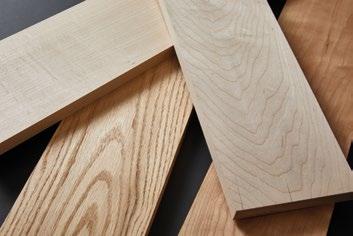


The hardwood forests of the eastern United States contain a wide range of temperate hardwood species, which have been managed for commercial and non-commercial purposes since the turn of the 20th century.
The American hardwood industry, which dates back to the first European settlers, has a wealth of experience in processing the native hardwoods of North America. The U.S. hardwood resource is mainly located in the east, from Maine in the North to the Gulf of Mexico in the South, and westwards across to the Mississippi valley. The USA has more temperate hardwood species than any other region of the world.
Few other countries can boast the success America has had in the sustainability of its hardwood forests. Due to the intensive application of Best Management Practice (BMP), the hardwood forests of America support a vibrant, healthy stand of timber, as well as a large and diverse wildlife population, clean rivers and streams, and a host of recreational activities. The last 90 years of improved forest management, state and federal regulations, together with greater silvicultural understanding and public desire to conserve forests, have resulted in a dramatic recovery and renewal of the American hardwood resource.
The hardwood sawmilling and processing industry, which depends upon this resource, is the largest producer of sawn hardwood in the world. In recent years, the U.S. has substantially increased exports and through careful management of its forests, the United States is growing more hardwood each year than it harvests, ensuring reliable, long term supplies. As the world faces environmental change, with sustainability at the forefront of people’s minds, materials that are natural and plentiful are key and the growing stock of the American forest has more than doubled since 1953.
Their availability and characteristics vary according to the region but every American hardwood species is growing at a far greater rate than it is harvested. Nations that have achieved this level of success in the sustainability of its hardwood forests are few.
Once harvested and milled, American hardwoods offer a great variety of colour, grain and character; from the warm, darker tones of red oak, cherry and alder to the lighter hues of maple, tulipwood and ash. Most of the species featured here can be used in a wide range of applications, from fine furniture to industrial sized structural panels.



Northern Region Long winters, short summers. Particularly suited to slow grown, tight grained hardwoods such as maple and birch.
Central Region Hot summers, cold winters. Particularly suited to species such as walnut, hickory and white oak.
Pacific Northwest Region
Maritime climate. Separated geographically from the main hardwood growing regions in the East. Red alder and Pacific Coast/ Big leaf maple grow exclusively here.
Southern Region Short winters, long hot summers. Producing fast grown large dimension species such as tulipwood, sapgum and ash.
Appalachian Region
Variable climate, due to differences in both elevation and latitude. Most hardwood species thrive here and is home to the largest concentration of cherry.
Note – Many American hardwood species such as ash, tulipwood, soft maple and the red and white oaks, grow across the Northern, Central, Southern and Appalachian regions. But, because of the variation in climate, soil type and elevation, the wood produced can vary significantly in colour, grain and other physical properties.
Wood is a natural material derived from a dynamic resource and as a result, the American hardwoods presented in this guide vary greatly in look, character and performance from species to species. Single species can also vary from one region to another, depending on climate, soil and altitude as well as forest management. This exciting palette can provide great opportunity for design, but it is essential to choose the right species that are fit for purpose. These guidelines, while not exhaustive, are our recommended starting points for conversations to source American hardwoods, ensuring you select species that are suitable for specific applications.
There are many sources of information on the characteristics and working properties of American hardwood species and these are well worth checking to avoid mistakes in processing. For example, oak is very strong and hickory is very hard for flooring, while some others are not. Some species will be more susceptible to movement under varying moisture conditions than others.
The look, or aesthetic, is one of American hardwoods’ most attractive features, so consider colour, grain and finishing before selecting. For example, cherry polishes to a very fine finish, which is hard to achieve in cottonwood. Natural colour variations exist within most U.S. hardwood species, such as differences in heartwood and sapwood, or mineral streaks. Also be aware that some species will change colour over time on exposure to light. Generally, lighter coloured timbers such as cherry and tulipwood will darken and darker timbers such as walnut will lighten.
One single species can vary according to where it is grown, influenced by climate, length of growing season, temperature according to altitude and more. American exporters and their overseas importers can help explain these differences. For example, ash or oak from the North will likely be quite different to southern oak and ash. These differences can be minimised by sourcing from just one geographical area.
As well as regional differences, species can often display variances within a single source, according to the amount of sapwood and heartwood. The difference between the two is minimal in some species (like oak), but in others (like willow) it is much more pronounced. American tulipwood (also known as yellow poplar in the USA) can have huge variances within a single parcel of logs that may be determined just by their diameter.
This is a case of ‘same but different’. Some American hardwood species have numerous sub-species. For example, there are about eight red oak and eight white oaks commercially available and, while they are generally the same and all sold as red and white oak, there can be subtle differences. For example, some red oaks grow faster and these may have more open grain, also affected by provenance.
It is important to know the practical limitations of length, width, thickness, drying shrinkage and availability of quality in a given species. We believe this starts in the forest where there is a considerable difference in the size of trees grown; tulipwood is one of the tallest, whereas walnut is generally much smaller and shorter affecting the lumber specifications that are available. Once trees have been harvested, sawmills do not cut logs longer than 16ft (4.8m) and in many species, widths over 12 inches (300mm) are limited. Remember FAS grade (see glossary on page 99) walnut does not come clear in 25-foot lengths. Specify airdried (AD) or kiln-dried (KD) to defined moisture content (MC). The bulk of hardwood lumber production is focused on thinner sizes such as 25mm and 32mm (produced in feet and inches and expressed as 4/4inch and 5/4inch) and although thicker sizes are available in some species, volume may be limited.
If you are sourcing American hardwood lumber, either directly from the USA or from distributors, it is absolutely essential to understand the NHLA (National Hardwood Lumber Association) grading principles, which indicate yield for specific purposes, to avoid overpaying or underspecifying. For example, furniture manufacturers can achieve excellent yield from No.1 Common ‘furniture’ grade or even lower, whereas joinery and door manufacturers may need the longer lengths of clearer wood only achieved in FAS grade. Your cost is determined by yield, not just price. Grades can be modified by suppliers through negotiation.
In contrast to sawn lumber, veneer producers tend to set their own grades according to customer requirement, grouped as panel, furniture and backing grades.
Finally, the best advice is to work with, and listen to, your supplier, whether they are a direct U.S. exporter or an in-country distributor or manufacturer, to understand your needs. These companies distribute the raw material, produce components or finished products that can be specified by architects and designers or consumed by end-users. Regional trade associations, federations and technical wood organisations can provide local market access to companies trading and manufacturing in American hardwoods. Visit americanhardwood.org for more information.
American hardwoods are legal, sustainable and have low environmental impact. We know this because:
• The Assessment of Lawful Harvesting & Sustainability of U.S. Hardwood Exports, commissioned by AHEC from Seneca Creek Associates in 2008 and comprehensively reviewed and updated in 2017, demonstrates there is less than a 1% risk of any illegal wood entering the U.S. hardwood supply chain.
• The U.S. Forest Service Inventory and Analysis (FIA) Program which shows that between 1953 and 2017, the volume of U.S. hardwood growing stock increased from 5.2 billion m3 to 12.0 billion m3 , a gain of over 130%.
• On-going scientific Life Cycle Assessment work which shows that the carbon stored in American hardwood at point of delivery to any country in the world almost always exceeds the carbon emissions associated with extraction, processing and transport.
Drawing on these and other independent sources, AHEC has developed online systems to allow U.S. hardwood exporters to provide a comprehensive American Hardwood Environmental Profile (AHEP) with every individual consignment of product delivered to any market in the world.
You can explore the environmental profile of American hardwoods in more detail using these online tools, available at americanhardwood.org:
• The Interactive Forest Map provides detailed information on forest volume, growth and harvest for individual hardwood species at state and county level throughout the United States.
• The LCA Tool provides environmental impact data such as carbon footprint, forest replenishment time, acidification, and eutrophication for individual hardwood species and lumber thicknesses and a wide range of transport scenarios.
A key priority for AHEC is ensuring that neither the value nor the reputation of legally harvested American hardwood is undermined in world markets by competing products from illicit sources. The U.S. hardwood industry supports legislation prohibiting trade in illegally harvested timber and through AHEC, provides tools to demonstrate the negligible risk of any U.S. hardwood being derived from an illegal source.
The Assessment of Lawful Harvesting & Sustainability of U.S. Hardwood Exports commissioned by AHEC from Seneca Creek Associates compiles detailed information on the scope, effectiveness and enforcement of federal, state, and local regulatory programs in U.S. hardwood producing states. The Seneca Creek study, which was first commissioned in 2008, was peer reviewed and fully revised in 2017.
The Seneca Creek study shows that there is less than a 1% risk of any illegal wood entering the U.S. hardwood supply chain. This is due to the combined effects of clear and fully enforced property rights, multi-generational family forest ownership, respect for the rule of law and a strong civil society.
The 2017 Seneca Creek study concludes that: “a safety-net of federal and state laws and regulations, resource assessments and forest and wildlife action plans, Best Management Practices (BMPs), professional logger training, forest health monitoring and protection, conservation programs, technical assistance, outreach and cost-share incentive programs, are effective in assisting family forest owners in achieving legal and regulatory compliance, broadening the professionalism of forest workers and promoting sustainable forestry practices. Overall, federal and state forest programs contribute to ensuring sustainable and legal hardwood supplies”.
The methodology and conclusions of the updated 2017 Seneca Creek study were assessed by an Independent Expert Review Panel in 2018. The Panel concluded that: “the Seneca Creek study provides a robust repeatable and defensible risk analysis that demonstrates the low risk of timber coming from illegal or unsustainable sources”.
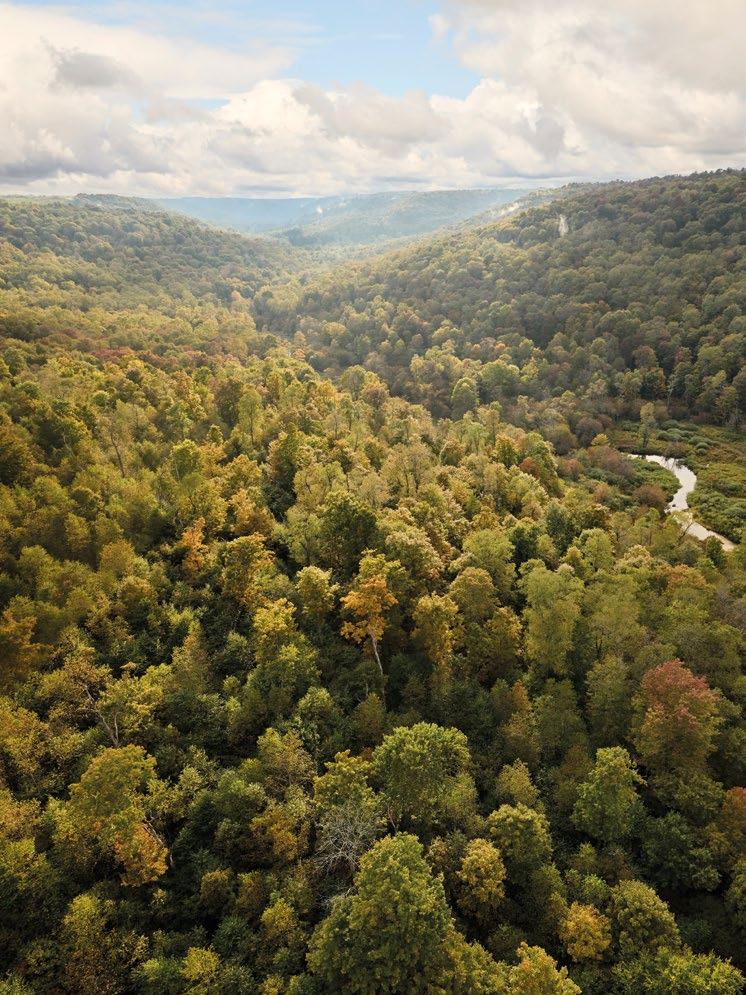

AHEC was a leading supporter, through membership of the U.S. Hardwood Federation, of the U.S. Lacey Act Amendment of May 2008. This makes it an offence within the U.S. to possess any plant (excluding agricultural crops but including wood and derivative products) “taken, possessed, transported, or sold” in violation of any relevant foreign or state law.
AHEC has also been closely involved with, and fully supports, the efforts by the European Union to enforce the EU Timber Regulation (EUTR) from 3 March 2013. This regulation imposes mandatory requirements on companies that “first place” forest products on the EU market to implement a “due diligence system” to assess and mitigate the risk of illegal wood entering the supply chain. Similar laws are now being enforced in Australia, Japan, Indonesia, Malaysia, Norway, and South Korea and are being considered for adoption in several other countries including Switzerland and Vietnam.
To help buyers of U.S. hardwood lumber to comply with EUTR and similar laws, AHEC has developed an online system to allow U.S. hardwood exporters to potentially create an American Hardwood Environmental Profile (AHEP) with every consignment of lumber delivered to any market in the world.
Each AHEP aligns to the requirements of the EUTR and closely follows the EU Guidance Document for the EU Timber Regulation. The AHEP provides, for each consignment, access to information on the name of the U.S. supplier, product description, quantity of wood, commercial and scientific species name, place of harvest and documents demonstrating negligible risk of illegal harvest alongside other environmental impact data.
While laws like EUTR place the due diligence obligation firmly on the importer, AHEC has also prepared Members Guidance on the EU Timber Regulation and Guidance on the Australian Illegal Logging Prohibition Act to ensure that U.S. hardwood exporters are fully briefed on the legal obligations and therefore better able to assist their overseas customers.
AHEC’s Interactive Forest Map shows the growth of species at national, state and county levelWhile forests are dynamic eco-systems in which species composition will shift over time, regular forest inventories undertaken by the federal government demonstrate that there is rapid growth in the volume of nearly all commercial hardwoods in U.S. forests. This growth is also well distributed throughout the U.S. hardwoods forests.
According to the latest statistical update by the United States Department of Agriculture (USDA):
• Between 1953 and 2017 the volume of U.S. hardwood growing stock increased from 5.2 billion m3 to 12.0 billion m3 , a gain of over 130%.
• U.S. hardwood forests are aging and more trees are being allowed to grow to size before being harvested. The volume of hardwood trees with diameters 48cm or greater increased nearly four-fold from 0.73 billion m3 in 1953 to 2.8 billion m3 in 2017. The proportion of hardwood trees in this mature age class increased from 14% in 1953 to 24% in 2017.
• The total area of hardwood and mixed hardwoodsoftwood forest types in the U.S. increased from 99 million hectares in 1953 to 117 million hectares in 2017, an average of 280,000 hectares per year – that’s equivalent to adding an area the size of a soccer pitch every 90 seconds throughout the entire 64 year period.

The rapid expansion of U.S. hardwood forest owes much to the fact that it is predominantly owned by a large number of private individuals and families whose primary motivation is usually not timber production or economics.
Of the total hardwood harvest in 2016, 89% came from privately owned lands and only 11% from public lands. In the Eastern States, which accounted for 98% of all U.S. hardwood harvested in 2016, there are 9.75 million forest owners, each with an average of 15 hectares. Only 5% of private forest area is owned by corporations and the average size of corporate holdings is only 133 hectares.
According to the National Woodland Owner Survey undertaken every five years by the U.S. Forest Service, the most commonly cited reasons for owning family forests relate to the beauty and privacy the forests provide, along with wildlife and nature protection.
The owners of U.S. hardwood forests usually grow their forests on longer rotations and typically harvest selectively a few trees per hectare, rather than clear-felling. Furthermore, after harvesting, forest owners usually rely on natural regeneration, which is abundant in the deep fertile forest soils of the U.S. In 2017, natural forests accounted for 97% of the area of hardwood and mixed hardwoodsoftwood forest types in the U.S. and only 3% were plantations. Even in the plantations, no non-native “exotic” or genetically modified species are used.
AHEC's Interactive Forest Map provides more detailed information on hardwood forest volume, growth and harvest at state and county level throughout the United States.

American red oak is the dominant species in the U.S. hardwood forests – with distinctive grain, and wood that is not always red in colour. The name comes from the leaf colour in the fall. Red oak may be sold on the basis of ‘Northern’, ‘Southern’ and ‘Appalachian’. There are several commercial sub-species of American red oak.
LATIN NAME
Quercus species, principally Quercus rubra
OTHER COMMON NAMES
northern red oak, southern red oak
WOOD DESCRIPTION
• In general the sapwood of red oaks is light brown and the heartwood is often, but not always, pinkish to reddish brown. The colour difference between the sapwood and heartwood is quite distinct. The wood of red oak is generally straight-grained and coarse textured.
• The wood is figured with medullary rays – a feature of all true (Quercus) oaks – smaller in red oak than white oak. The wood is porous, and easily identified from the end grain, so not suitable for wine barrels.
 Fugu by Jasper Morrison Studio for Tristram Hunt, Victoria & Albert Museum as part of Legacy
Fugu by Jasper Morrison Studio for Tristram Hunt, Victoria & Albert Museum as part of Legacy
1.04 seconds
REGENERATION RATE
It takes 1.04 seconds to grow 1m³ of American red oak
The replacement rate is calculated from total U.S. annual increment of the specified hardwood species derived from the U.S. Forest Service Inventory and Analysis (FIA) program and assumes that 2m³ of logs is harvested to produce 1m³ of lumber (i.e. 50% conversion efficiency). The rapid rate of replacement is due to the very large volume of hardwood trees in U.S. forest.
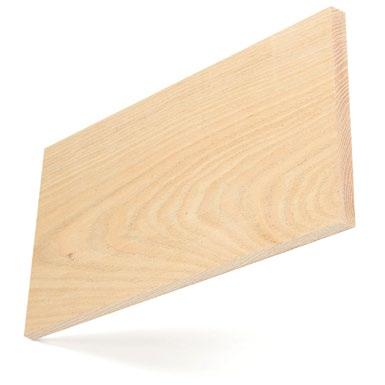
MECHANICAL PROPERTIES
All American red oaks have very good overall strength properties relative to weight. The wood is hard and heavy with medium bending strength, stiffness and high crushing strength. It has excellent steam bending capability. Being hard, stable when dry and easy to finish and stain, it is ideal for furniture, flooring and all forms of interior joinery.
More information about the mechanical properties of red oak and its structural potential can be found at americanhardwood.org
0.63
Specific gravity (12% M.C.)
705 kg/m3
Average weight (12% M.C.)
10.8%
Average volume shrinkage (Green to 6% M.C.)
98.599 MPa
Modulus of Rupture
12,549 MPa
Modulus of elasticity
46.610 MPa
Compressive strength (parallel to grain)
5,738 N
Hardness
D40
Structural Eurocode 5 design value
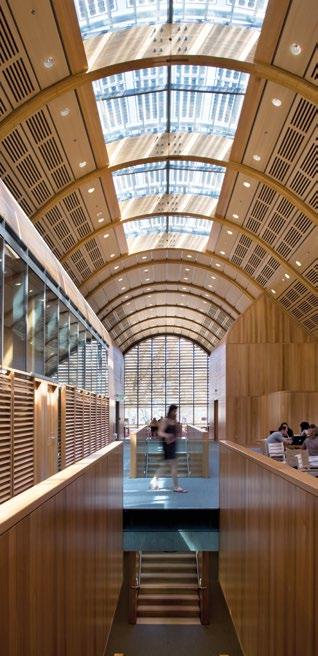
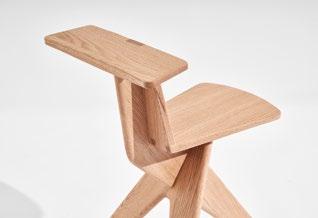


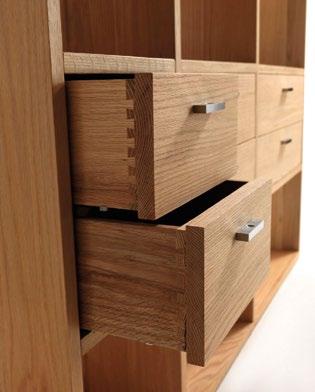
Red oak from the USA is readily available as sawn lumber and veneer, in a wide range of grades and sizes. Thicker lumber 10/4" (63.5mm) & 12/4" (76.2mm) can be sourced in relatively small volumes from specialist suppliers, but is widely produced throughout the hardwood industry from 4/4" (25.4mm) through to 8/4" (50.8mm). In the north the sapwood tends to be less, due to the shorter growing season, than in the south where the wood is grown faster with more open grain and texture. Red oak may be sold on the basis of ‘northern’ and ‘southern’, but this may be an over-simplification of the differences according to growing location.
Volume of live trees on forest land, 1000m3
0-30K
FOREST DISTRIBUTION
Red oak trees grow only naturally and almost exclusively in North America, although planted elsewhere. They are widely distributed throughout most of the eastern United States in mixed hardwood forests. The trees are very tall. There are many sub-species, all within the red oak classification, which grow from north to south; some high in the mountains and others on low land giving rise to different characteristics. Thus there are significant variations in red oaks depending on location, in particular between the slower grown northern and faster grown southern trees. Red oaks are regarded as highly sustainable for both domestic and export consumption and, being the largest species group, are more abundant than the white oaks.
Red oak lumber machines well, with good performance in nailing and screwing, although pre-boring is recommended. It glues well and can be stained and polished to a very good finish. Being porous, red oak absorbs all treatments. The wood dries best slowly to minimise degrade, but with high shrinkage and, like all oaks, can be susceptible to movement in performance in humid conditions. The wood is rated as slightly resistant to heartwood decay, but moderately easy to treat with preservatives. With care, red oak is also suited for thermal modification (see page 54).
This sustainably managed species group from natural forests of North America, with excellent environmental credentials, is a key species in many export markets. Its main uses are in furniture, flooring, windows, doors, architectural joinery, mouldings and kitchen cabinets. It also has the potential to be used in certain applications for construction, such as glulam.
Mouldings Flooring Furniture Doors Cabinets
FIA data shows U.S. red oak growing stock is 2.62 billionm3 , 17.9% of total U.S. hardwood growing stock. American red oak is growing 60.6 million m3 per year while the harvest is 31.9 million m3 per year. The net volume (after harvest) is increasing 28.7 million m3 each year. U.S. red oak growth exceeds or is in balance with harvest in all states except Texas.

Bloomberg’s European Headquarters in the City of London is a major showcase project, designed by a Foster + Partners team, led by Norman Foster himself. Red oak is used throughout the building in considerable quantities – totaling over 40,000 m2
The Vortex is a dramatic double-height space at the main entrance of the headquarters. 6,000 unique panels of red oak veneer had to be put together, much like a large jigsaw that could only be assembled in a particular sequence. The multipurpose room is a flexible space for meetings and presentations adjacent to the building’s auditorium. American red oak used in the form of glulam, comprising the ‘fin walls’ which define the space. An innovative approach to the flooring means that it doesn’t create any footfall noise. Each red oak floorboard has a magnetic strip running its length, sticking to the metal access floor below, so each piece can be lifted with ease and dropped back into place.
“Businesses now want their buildings to have a different sense of personality and be more responsive to people who work in them. Timber is rather successful in delivering both these things. People warm to it and it makes them feel better about their environment. And, while each building is the result of conversation between client and architect, for sure we may use more red oak. Bloomberg loves the result it’s delivered and so do we.” – Michael Jones, Foster + Partners.

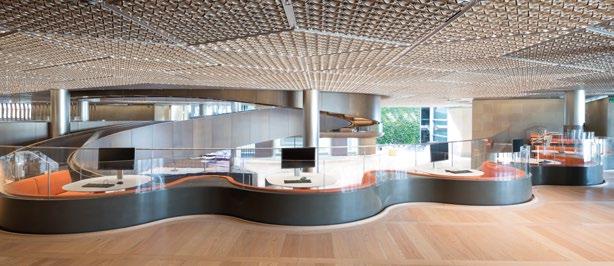
Commercially American tulipwood is one of the most prolific hardwood species from the U.S. hardwood forests and is unique to North America, having been eliminated in Europe by the last ice age.
LATIN NAME
Liriodendron tulipifera
OTHER COMMON NAMES
yellow poplar, tulip poplar, canary whitewood; not to be confused with European or Chinese poplar
WOOD DESCRIPTION
The grain characteristic of tulipwood is muted in comparison to species such as ash and oak, and is more like maple in character but darker in colour. However, there is a marked difference between the sapwood and heartwood of tulipwood. The sapwood is creamy white whereas the heartwood can vary from pale yellow, or brown, and even green to purple in extreme cases. The wood darkens with time when exposed to UV light and the green colour will turn brown. The wood of tulipwood is straight-grained with a medium to fine texture.
 Nieuwegein’s Theatre and Arts Centre by Frits van Dongen and Patrick Koschuch
Nieuwegein’s Theatre and Arts Centre by Frits van Dongen and Patrick Koschuch
1.82 seconds
REGENERATION RATE
It takes 1.82 seconds to grow 1m³ of American tulipwood
The replacement rate is calculated from total U.S. annual increment of the specified hardwood species derived from the U.S. Forest Service Inventory and Analysis (FIA) program and assumes that 2m³ of logs is harvested to produce 1m³ of lumber (i.e. 50% conversion efficiency). The rapid rate of replacement is due to the very large volume of hardwood trees in U.S. forest.
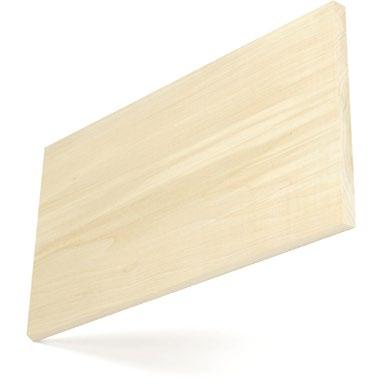
MECHANICAL PROPERTIES
Tulipwood has extraordinary overall strength properties relative to weight, making it highly suitable for structural applications, such as glue-laminated beams and cross laminated timber (CLT). The wood has relative low density, with high bending, shock resistance, and stiffness values, but is lower in compression and hardness. The wood has medium steam-bending capability and is extremely stable when fully dry and not installed in humid conditions. It is easy to finish and stain or paint, so it is highly suitable for most furniture.
More information about the mechanical properties of tulipwood and its structural potential can be found at americanhardwood.org
0.42
Specific gravity (12% M.C.)
449 kg/m3
Average weight (12% M.C.)
9.8%
Average volume shrinkage (Green to 6% M.C.)
69.640 MPa
Modulus of rupture
10,894 MPa
Modulus of elasticity
38.198 MPa
Compressive strength (parallel to grain)
2,402 N
Hardness
* Tulipwood achieves D40 for its strength and stiffness, but it is not listed in Eurocode 5, because it does not meet the minimum density requirement. A full set of test values can be accessed at americanhardwood.org

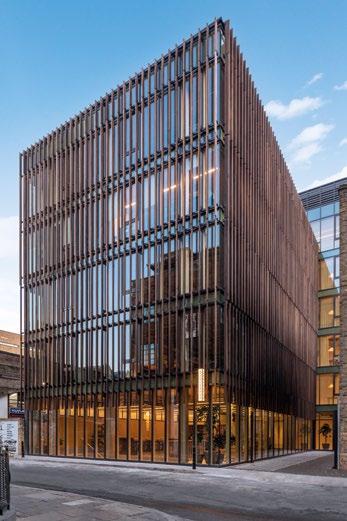
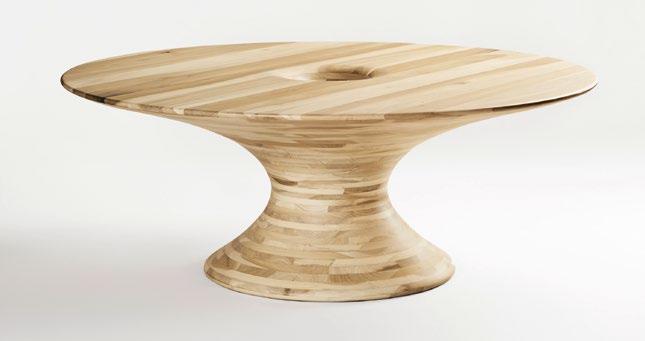
Tulipwood from the USA is readily available as sawn lumber in a wide range of grades and thicknesses (4/4" through to 16/4") due to its ease of drying. A relatively large forest tree which can produce higher average lumber widths and lengths than other commercial species. Average lumber widths and lengths can be higher than other commercial species. Tulipwood is used in plywood production but with more limited availability as decorative veneer. The sapwood produces the often preferred whiter wood, as the heartwood usually exhibits strong colour variation. However the use of unsorted tulipwood displaying all its natural colour variation is on the increase, especially in Europe. Tulipwood is sold domestically, and sometimes referred to in export, as ‘poplar’ but should not be confused with European or Chinese poplar.
Volume of live trees on forest land, 1000m3 0-30K
• Tulipwood lumber is easy to machine, plane, turn and glue with good screwing performance, although pre-boring is recommended. It tends to split when nailed. Tulipwood can easily be stained and polished, or painted, to a high quality finish. The wood is stable when dry, but can be susceptible to movement in performance in humid conditions.
• The wood is non-resistant to decay. The heartwood can be resistant to preservative treatment, whereas the sap is permeable. Overall, tulipwood can be considered for preservation with modern preservative treatment methods including thermal modification, to which it is well-suited.
This sustainably managed wood from natural forests of North America, with excellent environmental credentials, is a key species in many export markets. Its main uses are in furniture, doors, panelling, architectural interior joinery and mouldings and kitchen cabinets. It is also used in certain applications for construction and in some specialist applications such as carving.
Mouldings Carving Furniture Doors
Tulipwood trees grow exclusively in North America and are widely distributed throughout most of the eastern United States in mixed hardwood forests. It is a single species that is not a true poplar (Populus), and is part of the Magnoliacae family producing wood that is superior to the many poplar species. The trees are huge and identified by their tulip-like flowers giving rise to the name. Each tree can produce millions of seeds annually. Tulipwood grows from north to south and is one of the most sustainable hardwoods in the USA.
Panelling Cabinets Glulam Beams CLT
FIA data shows U.S. tulipwood growing stock is 1.12 billionm3 , 7.7% of total U.S. hardwood growing stock. American tulipwood is growing 34.6 million m3 per year while the harvest is 12.8 million m3 per year. The net volume (after harvest) is increasing 21.8 million m3 each year. U.S. tulipwood growth exceeds harvest in all states.
American tulipwood forest volume
1.1 (billion)
U.S. forest volume 14.6 (billion)
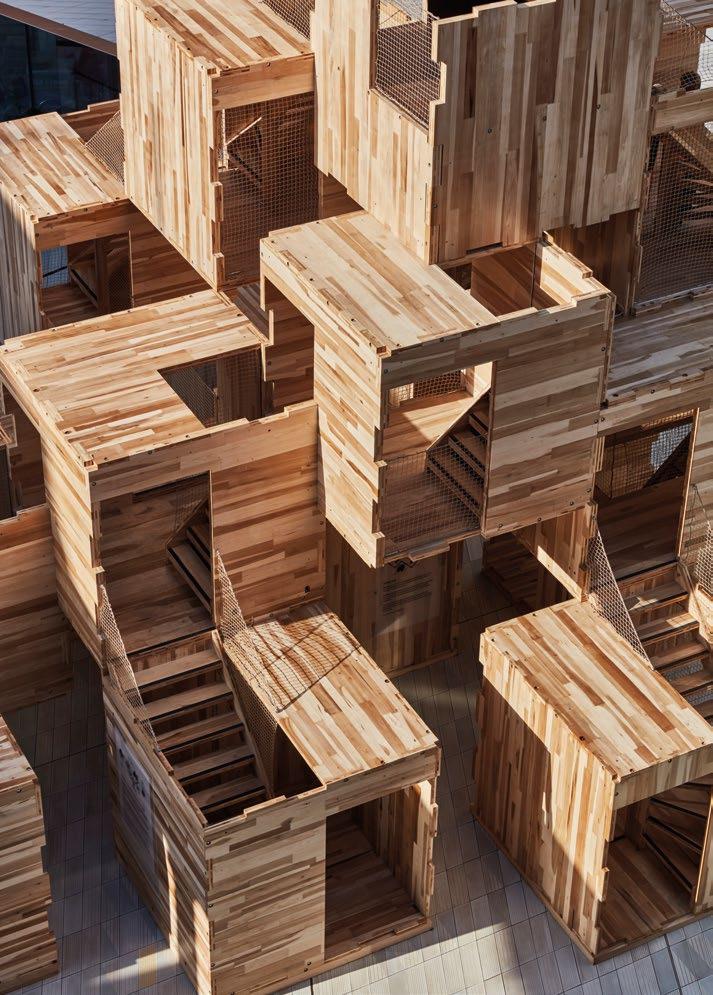
The development of cross-laminated timber, or CLT, has transformed the structural use of timber. From small beginnings in the mid-1990s, building in CLT is now a widely-accepted and increasingly popular method of timber construction, especially for larger commercial developments. The last 20 years has seen an exceptional rise in its use. Reasons for this are related to its outstanding capability for prefabrication and its remarkable structural and environmental benefits.
The versatility of CLT is leading to new and innovative timber buildings. There are many benefits to building in CLT: the speed of build is much quicker; the build process is less noisy, and timber construction is much lighter, meaning reduced foundation requirements and the prospect of extra storeys. The environmental advantages are considerable too, with the timber panels acting as long-term carbon stores. The health and wellbeing offered by timber buildings is also now well-documented and the insulation and thermal performance of the building is considerably improved.
CLT is a clever way to create large structural panels from small pieces of timber. CLT consists of planks (or lamellas) of sawn, glued, and layered wood, where each layer is oriented perpendicular to the previous one. By joining layers of wood perpendicular to each other, structural rigidity for the panel is obtained in both directions, similar to plywood but with thicker components. In this way, the panel has great tensile and compressive strength. These panels can be used to form wall, floor and roof panels. The panels are quick to produce in a factory environment and they can be machined to very high tolerances. Panel sizes are typically 16 metres by 2.95 metres but can be larger.
The first CLT factories started operating in Europe in the early 1990’s utilising the abundant supply of the native softwood, pine and spruce. For 20 years, Europe dominated CLT production but it is now developing as a global business with new factories opening in all major continents, with each region exploring its potential with raw material that is the most cost effective and abundant.
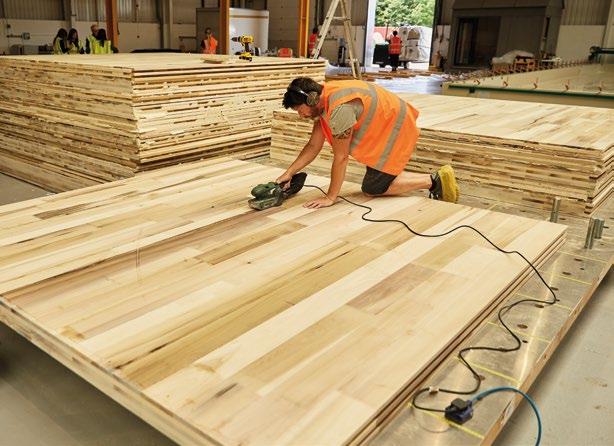
Since 2012, AHEC, working in close collaboration with engineering consultants ARUP, have pioneered research and undertaken experiments with enlightened architects, into the potential of using hardwood as an alternative fibre resource to softwood for CLT manufacturing. AHEC identified American tulipwood as an ideal pioneer species due to the fact it is exceptionally strong for its weight. The thinking behind this research was to offer relatively thin CLT panels of much higher strength and stiffness, together with a different aesthetic, to the look of softwoods. Over the last 10 years AHEC has collaborated on a number of landmark CLT projects utilising American tulipwood CLT and each project has been undertaken with an element of research and development to expand the knowledge around American tulipwood as a raw material for commercial hardwood CLT production.
The first demonstration of the CLT potential of American tulipwood was the Endless Stair , designed by dRMM architects as a landmark project for the London Design Festival in 2013. Inspired by the images of Dutch graphic artist, M.C. Escher, the three storey network of stairs is now widely recognised as the pioneer use of hardwood in CLT manufacture. Tests at Trento University on the strength properties of the small experimental CLT panels, produced in Italy by Imolegno, revealed superior strength compared to spruce, with rolling sheer values, a key performance indicator, three times greater.
Building on what was learnt for Endless Stair , AHEC approached Alison Brooks Architects in 2016, challenging them to push the boundaries of what was possible with tulipwood CLT by working with some of the largest hardwood panels ever produced. These first ever industrially produced hardwood CLT panels, including some curved, were produced in Germany by Zueblin Timber. The result was The Smile, another landmark project for LDF, a 34m long double cantilever inverted arc that was capable of carrying up to 60 people at either end. The 12 multi layered panels up to 14m long and 4.5m wide were connected by more than six thousand self-tapping screws. The Smile is still widely acknowledged as one of the most complex and challenging CLT structures ever built and could not have been made in softwood.
2017 saw the completion of the first permanent building made from American tulipwood CLT, Maggie’s Cancer Centre in Oldham in the UK, designed by dRMM Architects. This award winning building is thoughtful, holistic, therapeutic, warm and filled with surprises – even the smallest detail has been carefully considered and chosen to improve patient wellbeing. It stands as a pivotal moment for modern architecture and timber in construction.
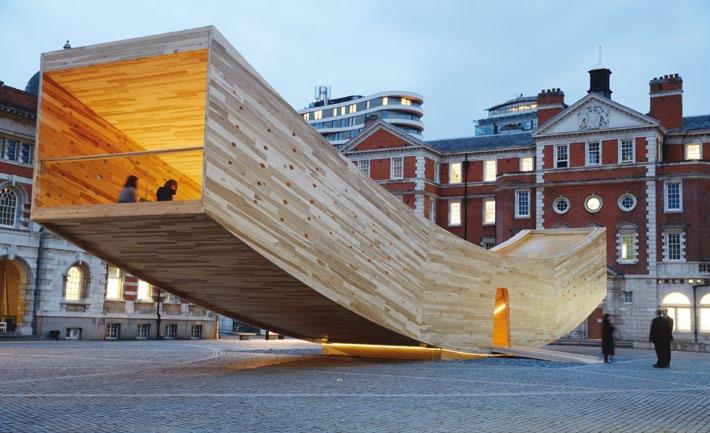
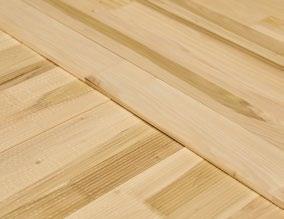
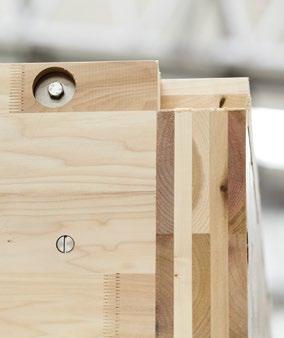
The most recent demonstration of the structural capability of tulipwood CLT was in the 2018 London Design Festival project MultiPly – a three storey, three dimensional maze structure designed by Waugh Thistleton Architects. The complete structure comprised 17 interconnecting modules made from more than a hundred 60mm and 100mm thick, 2.6m square CLT panels. This modular structure with its flexible design and connection detail allowed it to be re-erected in a different configuration as part of Milan Design Week in 2019 and again in a new cuboid arrangement for the 2020 Madrid Design Festival.

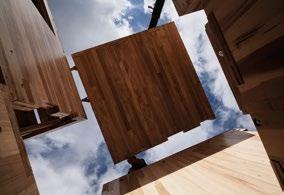
Working with ARUP, Construction Scotland Innovation Centre (CSIC) Glenalmond Timber and Napier University, AHEC were able to produce the first ever CLT panels made in the UK. During the manufacturing process, data collection and testing made it possible to create a detailed production schedule for tulipwood CLT and enable a comparison with published data for softwood CLT. The information is available in a technical document Tulipwood CLT Properties and Manufacturing Requirements. This publication together with detailed information on all AHEC’s tulipwood CLT projects can be accessed at americanhardwood.org
CLT panels laid perpendicular to one another Endless Stair by dRMM Architects and Arup for London Design Festival 2013 Detail of panel to panel connection jointAmerican cherry is a supreme hardwood species from the U.S. hardwood forests and is unique to North America, with warm colour tones and superb finishing qualities. It is quite different in size and appearance to ornamental cherry trees.
LATIN NAME
Prunus serotina
OTHER COMMON NAMES
black cherry
The heartwood of cherry can vary from rich red to reddish brown and darkens on exposure to light with time. The sapwood is creamy white. Although the difference between heart and sap colour is marked, this can be reduced by steaming. The wood of cherry has a fine uniform, straight and unpronounced grain with a fine smooth texture. The small brown pith flecks, pin knots and gum pockets or streaks are natural characteristics of cherry, but their occurrence varies according to region.
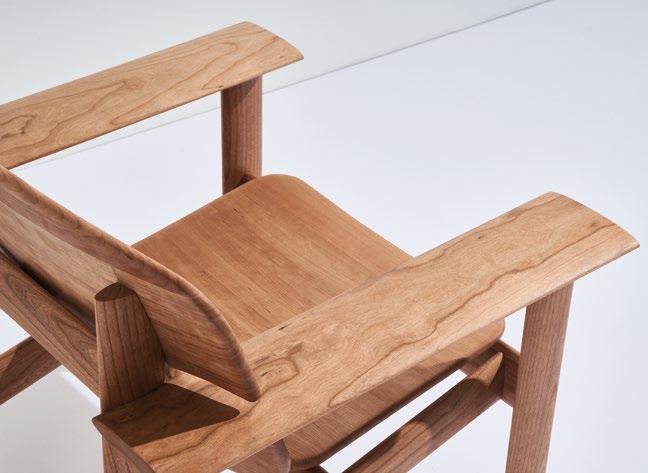
6.12 seconds
REGENERATION RATE
It takes 6.12 seconds to grow 1m³ of American cherry
The replacement rate is calculated from total U.S. annual increment of the specified hardwood species derived from the U.S. Forest Service Inventory and Analysis (FIA) program and assumes that 2m3 of logs is harvested to produce 1m3 of lumber (i.e. 50% conversion efficiency). The rapid rate of replacement is due to the very large volume of hardwood trees in U.S. forest.

MECHANICAL PROPERTIES
Cherry has medium density, with good wood bending properties, medium strength and shock resistance, but low stiffness, and can be steam bent with care. Being hard and stable when dry the wood is very easy to stain and finish to an excellent surface. It is highly prized for furniture and interior joinery. As a relatively soft species, American cherry is more suitable for flooring in areas with low traffic, such as bedrooms, or in cultures where shoes are not worn in homes – as in Asia.
0.50
Specific gravity (12% M.C.)
561 kg/m3
Average weight (12% M.C.)
9.2%
Average volume shrinkage (Green to 6% M.C.)
84.809 MPa
Modulus of rupture
10,274 MPa
Modulus of elasticity
49.023 MPa
Compressive strength (parallel to grain)
4,226 N
Hardness

• Cherry from the USA is readily available as veneer and sawn lumber in a range of grades and sizes, although limited as thicker material; 10/4" (63.5mm) & 12/4" (76.2mm). The species can be subject to cycles of popularity or fashion, so that apparent shortages of dry lumber available to deliver may not reflect the substantial resource available for harvest.
• Cherry may be sold selected for colour, defining the amount of sap-free material or sold sap-free one face. For example, cherry boards may be sold 90/50 meaning 90% heartwood on one face and not less than 50% heartwood on the reverse side – or sold in other specifications. Consultation with suppliers is recommended.
Volume of live trees on forest land, 1000m3
0-20K
FOREST DISTRIBUTION
American forest cherry trees grow principally in the northeast of the USA in mixed hardwood forests. The species is different from the many floral cherries planted throughout the world. It is a single species; the trees growing tall and often in dense stands in several U.S. states, notably Pennsylvania, New York, Virginia and West Virginia. Cherry has a relatively short rotation, taking less time to mature than other hardwoods. Much of the current resource is the result of cherry’s ability to regenerate naturally after forest fires.
• Cherry lumber is easy to machine, plane and turn. It glues well with good performance in screwing and nailing. It has excellent carving and moulding properties. Cherry can easily be sanded, stained and polished to a very fine and smooth finish.
• The heartwood is resistant to decay and is moderately resistant to preservative treatment.
• Users should take into account that both the heartwood of cherry can darken in tone quite quickly on exposure to light.
This sustainably managed wood from natural forests of North America, with excellent environmental credentials, is revered worldwide for its warmth of colour and fine finish. It is highly suitable for furniture, cabinet making and high class joinery. It is widely used for doors, panelling, architectural interior joinery, mouldings and kitchen cabinets, and some flooring. It is also used in certain specialist applications such as musical instruments and luxury boat interiors.
Mouldings Furniture Musical Instruments Doors Panelling Cabinets
FIA data shows U.S. cherry growing stock is 424.2 millionm3 , 2.9% of total U.S. hardwood growing stock. American cherry is growing 10.3 million m3 per year while the harvest is 4.9 million m3 per year. The net volume (after harvest) is increasing by 5.4 million m3 each year. U.S. cherry growth exceeds harvest in all the main producing states.
M³
American cherry forest volume
424.2 (million)
U.S. forest volume
14.6 (billion)

Designed for both opera and musical theatre productions, The Susie Sainsbury Theatre has been redesigned by Ian Ritchie Architects and sits at the heart of the Royal Academy of Music in London.
Inspired by the curved shapes of string instruments, the 309-seat American cherry-lined Theatre has been acoustically refined to deliver outstanding sound qualities.
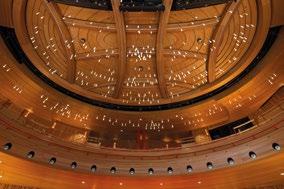
Architect Ian Ritchie comments on the space “In designing the new spaces, we took inspiration from the shape and wooden construction of string instruments, their tuning mechanisms and the physical relationships between artist and instrument. Our earliest research into the materiality of wood, how it is transformed and tuned, along with an awareness of the role of varnish in instruments made in Cremona, birthplace of Stradivarius, led us to exploit the haptic qualities that finished wood would give as a reflector of sound, warmth and light.
For the Theatre our ambition was to conceive a space that could give the sense of both intimate and epic qualities depending upon the chosen music, in contrast to the cool lime washed oak whiteness of the Recital Hall above the Theatre. The cherry-lined walls, ceiling, balcony front and balcony (Prunus serotina) of the Theatre have all been acoustically refined to deliver outstanding sound qualities with graded detailing to blend the sound in all directions and carefully angled surfaces creating a completely immersive experience for audiences.”

American ash is ideal for bending and turning. It is strong and tough with distinctive grain, character and colour.
Fraxinus species, principally Fraxinus americana
OTHER COMMON NAMES
northern ash, southern ash
• In general ash is a light coloured wood, with sapwood varying from white to yellow and heartwood light to dark brown, sometimes with lighter streaks. The colour difference between the outer light-coloured white sapwood and inner, darker, even brown heartwood is quite distinct. Ash wood is generally straight-grained with a coarse uniform texture. Its appearance has a very strong grain contrast between the softer summer growth and hard winter growth rings. No two pieces are ever the same in appearance.
• Light brown flecks, or mineral streaks, sometimes referred to as ‘glassworm’, are common in ash and are treated as a natural characteristic, and are not considered as a defect under the NHLA Grading Rules. They do not undermine the integrity of the wood.
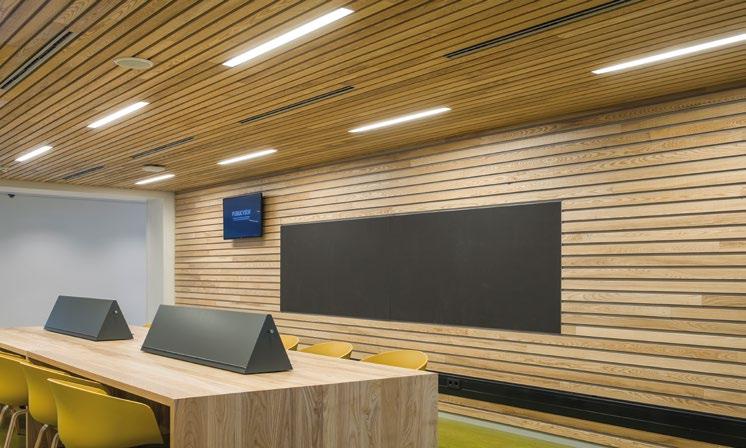
19.05 seconds
REGENERATION RATE
It takes 19.05 seconds to grow 1m³ of American ash
The replacement rate is calculated from total U.S. annual increment of the specified hardwood species derived from the U.S. Forest Service Inventory and Analysis (FIA) program and assumes that 2m³ of logs is harvested to produce 1m³ of lumber (i.e. 50% conversion efficiency). The rapid rate of replacement is due to the very large volume of hardwood trees in U.S. forest.
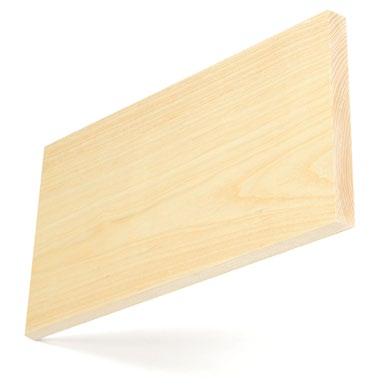
MECHANICAL PROPERTIES
Ash wood has very good overall strength properties relative to its weight. It has excellent shock resistance, which takes some of the pain from those using hand tools and sports equipment, such as baseball bats and hockey sticks. It steam bends very well, so is a favourite of furniture makers and hobbyists. Being very hard, stable when dry and easy to finish and stain, it is ideal for furniture and flooring.
To find out more about the mechanical properties of ash read the full structural guide.
0.60
Specific gravity (12% M.C.)
673 kg/m3
Average weight (12% M.C.)
10.7%
Average volume shrinkage (Green to 6% M.C.)
103.425 MPa
Modulus of rupture
11,997 MPa
Modulus of elasticity
51.092 MPa
Compressive strength (parallel to grain)
5,871 N
Hardness
D35
Structural Eurocode 5 design value


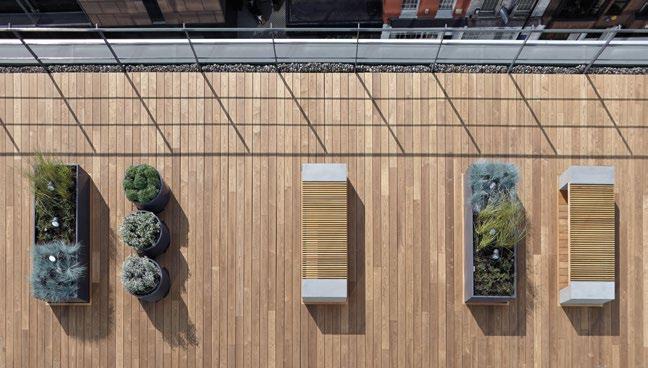
• Ash from the USA is readily available as sawn lumber and veneer, in a wide range of grades and sizes. In the north the sapwood tends to be less due to the shorter growing season, than in the south where the wood is grown faster with more open grain and texture. Ash may be sold on the basis of colour and is widely available for export, although its long term availability will be affected by the impact of Emerald Ash Borer (EAB) infestation.
• Ash lumber is available in a range of grades from 4/4" (1" or 25.4mm) through to 8/4" (2" or 50.8mm) although limited volumes of 10/4" (2.5" or 63.5mm) and 12/4" (3" or 76.2mm) can be sourced.
Volume of live trees on forest land, 1000m3 0-20K
Ash lumber machines well, with good performance in nailing, screwing, gluing and can be stained and polished to a very good finish. Black stained ash has experienced several successful fashion cycles in furniture. The wood dries fairly easily with minimal degrade. With good stability there is not much movement in performance. Ash veneer laminates well to board materials. Ash is not resistant to heartwood decay and the heartwood is moderately resistant to preservative treatment, but the sapwood is permeable. This makes ash very suitable for being thermally modified, as has now been proven through its widespread use for decking, cladding, worktops and garden furniture.
This sustainably managed wood from natural forests of North America, with its excellent environmental credentials, is popular with designers, architects, specialist users and consumers around the world. Its main uses are furniture, flooring, doors, architectural joinery and mouldings, kitchen cabinets, tool and sport handles.
Mouldings Flooring Furniture Doors
American ash trees grow commonly throughout the eastern United States in mixed hardwood forests, from the north in New York State to the southern States along the Gulf of Mexico, and everywhere in between. They grow high in the mountains and low on the plains and coastal areas giving rise to great variety of character. With such widespread distribution in latitude, climate and soil conditions, there are significant variations in ash depending on location, in particular between the slower grown northern and faster grown southern trees. There are also sub-species that add to this variety. Despite some longer-term threats by forest pests and disease to the ash standing stock of timber, ash is a prolific species. More information about the mechanical properties of ash and its structural potential can be found at americanhardwood.org
Forest Inventory Analysis (FIA) data shows U.S. ash growing stock is 657.8 million m3 , 4.5% of total U.S. hardwood growing stock. American ash is growing 3.3 million m3 per year while the harvest is 6.9 million m3 per year. Net volume (after harvest) is increasing -3.6 million m3 each year. The 2014 inventory indicates that U.S. ash growth exceeds harvest in all major supplying states except Michigan and Ohio, which are central to the Emerald Ash Borer (EAB) infestation. Ash mortality rates and removals are expected to rise in the immediate future, likely in excess of growth in some states, due to the EAB infestation.
(million)
(billion)

Maggie’s Cancer Care Centre in Oldham, UK is the world’s first building made from hardwood crosslaminated timber (CLT). The centre, designed by dRMM Architects, using American tulipwood CLT and thermally modified tulipwood cladding, was a pivotal moment for timber in modern architecture and construction.
Maggie’s is a charity that provides practical and emotional support to people living with cancer following the new ideology of cancer care laid out by Maggie Keswick Jencks. Built on the grounds of specialist NHS cancer hospitals, Maggie’s Centres are warm and welcoming places with qualified professionals on hand to offer a programme of support shown to improve physical and emotional wellbeing.
dRMM is a London-based studio of architects and designers, founded in 1995 by Alex de Rijke, Philip Marsh and Sadie Morgan. Since 2000 dRMM has pioneered the use of engineered timber as the most relevant material for 21st century architecture. The studio co-invented tulipwood CLT, alongside AHEC and Arup engineers, in 2013 for use in the groundbreaking structure, Endless Stair

This pioneering piece of permanent architecture is constructed from more than 20 panels of five layer cross-laminated American tulipwood, ranging in size from 0.5m – 12m long. The centre stands atop 4m steel legs on concrete pads within Royal Oldham Hospital grounds. Its garden slopes down before and panoramic vistas stretch to the Pennines.
The curve of the interior CLT walls hug the contours of the glass and poured resin floors reinforce the sense of flow. The slatted ceiling in the flat-roofed structure is also American tulipwood, made from leftover wood from the CLT fabrication process, ensuring minimal waste.
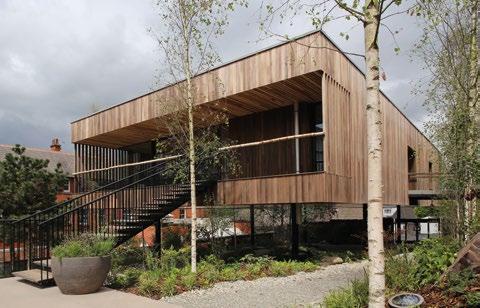
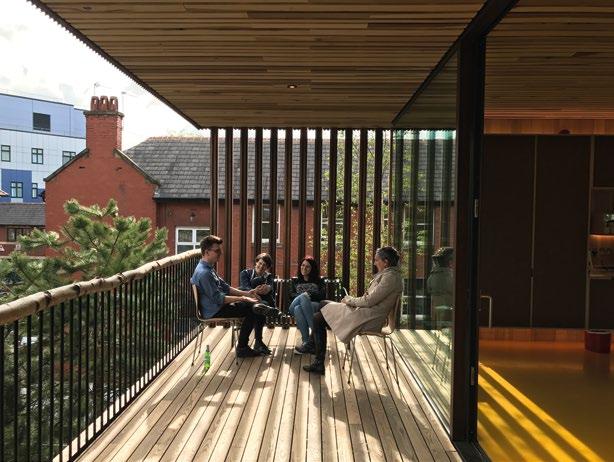
The Centre breaks further new ground by featuring thermally treated (TMT) – the first time that TMT tulipwood has been used to clad an entire structure in the UK.
dRMM chose tulipwood for the design of Maggie’s Oldham for the positive influence wood has on people and for the beauty, strength and warmth inherent to American tulipwood.
“In wood there is hope, humanity, scale, warmth, and nature’s clever plan to absorb carbon. Wood is a nontoxic, versatile, benign, anti-carcinogenic material. Maggie’s Oldham has a built-in, very visible holistic design message that supports the central aims of the design – to uplift and offer hope to people affected by cancer. The applications for sustainably grown hardwood, particularly fast growing tulipwood CLT is endless.” – Professor Alex De Rijke, Founding Director, dRMM Architects.
The finished building is thoughtful, holistic, therapeutic, warm and filled with surprises, - even the smallest detail has been carefully considered and chosen to improve the patient’s wellbeing.
The main kitchen table, which visitors are encouraged to sit around, is a design by Barnby Day that was commissioned by Alex de Rijke and AHEC for The Wish List for London Design Festival 2014. A second table was made by the craftsmen at Benchmark Furniture using recycled tulipwood CLT from the off-cuts from the windows and doors from Maggie’s Oldham.
American white oak replaces the cold metal, traditionally used for door handles and support rails, that can be harsh on sensitive skin caused by chemotherapy treatment.
Outside, thermally modified American ash decking is covered by the roofs canopy, American tulipwood, to offer shelter for those with light sensitive skin from radiotherapy, without detracting from the tranquil views over the hospitals gardens.

American white oak is one of the most popular species from the U.S. hardwood forests in export markets – and is unique to North America.
LATIN NAME
Quercus species, principally Quercus alba
OTHER COMMON NAMES
northern white oak, southern white oak
• White oaks have an attractive grain, similar to many other oaks grown globally. In general the sapwood of white oak is whitish to light brown and the heartwood is normally light to mid or even dark brown. The difference between the sapwood and heartwood of white oak is less distinct than in red oak. The wood of white oaks is mainly straight-grained with medium to coarse texture.
• The wood is figured with medullary rays – a feature of all true (Quercus) oaks – and these in white oak are longer than those of red oak; thus producing a more pronounced figure. The heartwood wood is not porous, so is suitable for wine barrels and exterior use.
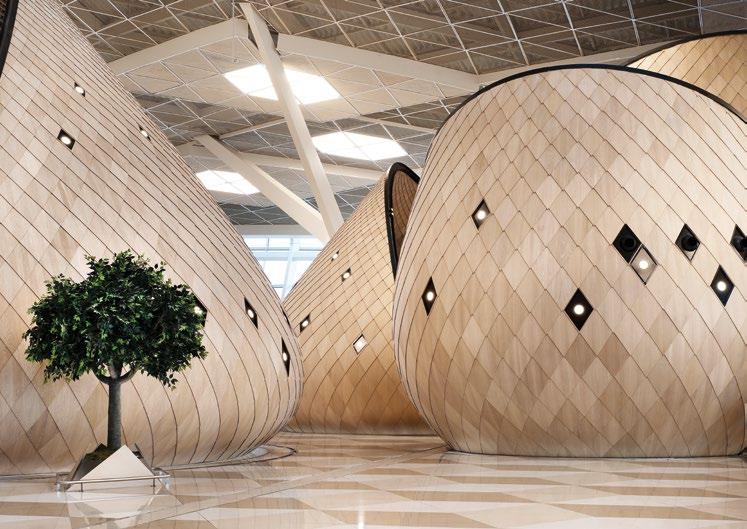 Heydar Aliyev International Airport by Autoban
Heydar Aliyev International Airport by Autoban
1.57 seconds
REGENERATION RATE
It takes 1.57 seconds to grow 1m³ of American white oak
The replacement rate is calculated from total U.S. annual increment of the specified hardwood species derived from the U.S. Forest Service Inventory and Analysis (FIA) program and assumes that 2m³ of logs is harvested to produce 1m³ of lumber (i.e. 50% conversion efficiency). The rapid rate of replacement is due to the very large volume of hardwood trees in U.S. forest.
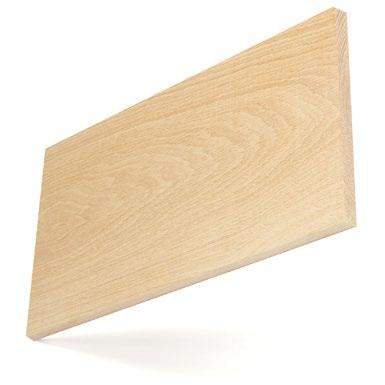
MECHANICAL PROPERTIES
American white oaks have excellent overall strength properties relative to weight, making them a preferred hardwood species for structural applications. The wood is hard and relatively heavy with good bending strength and compression strength but lower in stiffness. Structural testing carried out in Europe confirms that the white oak has greater inherent fibre strength than European oak. It has excellent steam bending capability. Being hard, stable when dry and easy to finish and stain, it is highly popular for furniture and flooring, especially in export markets.
More information about the mechanical properties of white oak and its structural potential can be found at americanhardwood.org
0.68
Specific gravity (12% M.C.)
769 kg/m3
Average weight (12% M.C.)
12.6%
Average volume shrinkage (Green to 6% M.C.)
104.804 MPa
Modulus of rupture
12,273 MPa
Modulus of elasticity
51.299 MPa
Compressive strength (parallel to grain)
6,049 N
Hardness
D50
Structural Eurocode 5 design value

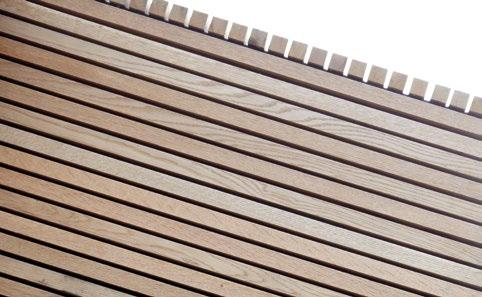
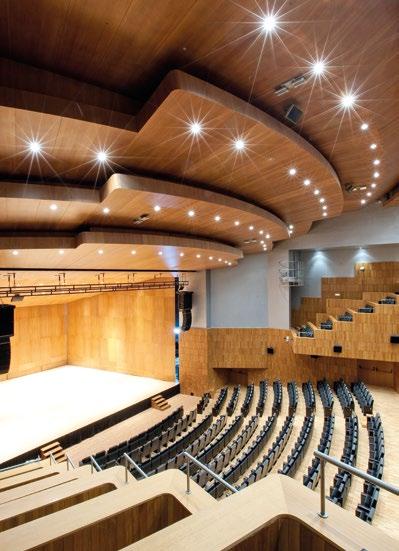
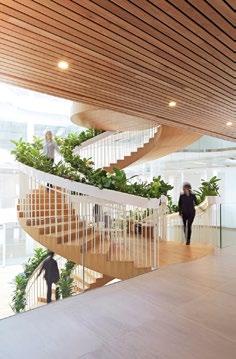
White oak from the USA is readily available as sawn lumber and veneer, in a wide range of grades and sizes. Due to lengthy drying times not all suppliers offer thicker lumber stock (10/4" & 12/4") but it is available in limited volumes. In the north the sapwood tends to be less than in the south where, due to the shorter growing season, the wood is grown faster with more open grain and texture. White oak may be sold on the basis of ‘northern’ and ‘southern’, but this may be an over-simplification of the differences according to growing location.
Volume of live trees on forest land, 1000m3 0-30K
White oak trees grow exclusively in North America and are widely distributed throughout most of the eastern United States in mixed hardwood forests. As with red oak there are many sub-species, all within the white oak classification, and together all the oaks form the most common species group accounting for about 33% of the American hardwood resource. The trees are tall and easily identified by their rounded leaf form, turning brown in the fall. White oaks also grow from north to south; some high in the mountains and others on low land giving rise to different characteristics. Thus there are significant variations in white oaks depending on location, in particular between the slower grown northern and faster grown southern trees. As with red oaks, they are regarded as very sustainable for both domestic and export consumption.
• White oak lumber machines well, with good performance in nailing and screwing, although pre-boring is recommended. It glues well (although the inclusion of primers are recommended for structural gluing) and can be stained and polished to a very good finish. The wood has to be dried slowly and carefully to avoid degrade and it has high differential radial and tangential shrinkage so can be susceptible to movement in performance in humid conditions. It has excellent drilling and finishing properties.
• The heartwood is resistant to decay and resistant to preservative treatment.
This sustainably managed wood from natural forests of North America, with excellent environmental credentials, is a key species in many export markets. Its main uses are in furniture, flooring, doors, architectural joinery and mouldings and kitchen cabinets. It is also used in certain applications for construction, including structural glue-laminated beams, and other specialist applications.
Mouldings Flooring Furniture Doors Cabinets Glulam Beams
FIA data shows U.S. white oak growing stock is 2.26 billionm3 , 15.5% of total U.S. hardwood growing stock. American white oak is growing 40.1 million m3 per year while the harvest is 20.1 million m3 per year. The net volume (after harvest) is increasing 20.0 million m3 each year. U.S. white oak growth exceeds harvest in all major supplying states.
2.3 (billion)
14.6 (billion)


The Marylebone Cricket Club (MCC) commissioned architects Populous to design the new Warner Stand at one of the world’s most iconic sporting facilities, Lord’s Cricket Ground in St John’s Wood, London.
The roof of the stand is formed from 11 cantilevered glue laminated (glulam) American white oak beams that radiate dramatically from the corner of the Ground, paving the way for brave new structural uses of sustainable American hardwoods.
Each beam measures 900mm x 350mm at the deepest point. The longest glulam beam weighs approximately 4 tonnes and measures 23.4 metres in length, the same as 26 cricket bats lined up nose to tail. It was the first time white oak had been employed in this format on this scale and in such a performance critical environment – forming the primary structure of a roof projecting out over 2,674 spectators.
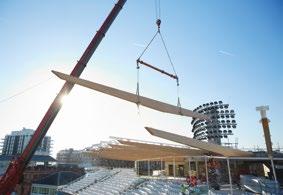
“Natural wood and cricket cannot be separated. The use of willow for cricket bats and ash for the stumps is as much part of the game as the leather balls, the state of the pitch and of course the weather. Populous chose to specify American white oak because it can be finely crafted, possesses a beautiful golden colour, and is immensely strong. These characterful qualities make it the perfect choice for the structure of a new canopy roof at Lord’s,” said Philip Johnson, Senior Principal at Populous, and Project Director.
Soft maple, growing naturally in the hardwood forests of North America, is one of the most prolific and sustainable species, similar to hard maple but slightly softer in impact hardness.
• Soft maples are somewhat like hard maple, but much more variable in colour, especially from one region to another. The sapwood of soft maple is normally greyish white but can be darker, with pith flecks as a natural characteristic. The heartwood of soft maple varies in colour from light to dark reddish brown. The difference between sap and heartwood is greater than in hard maple.
• The wood of soft maple is generally straight grained with fine texture, with a grain pattern similar to American cherry. Soft maple can be stained as a cherry substitute.
Soft maple from the USA is widely available as sawn lumber in a range of sizes and grades, but rarely as veneer. The lumber is normally sold unselected for colour. West coast production is usually sold surfaced and graded from the better side, in a departure from standard NHLA Grading Rules.
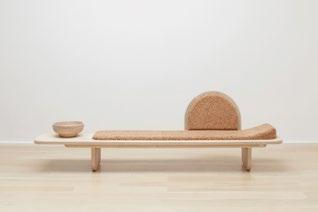
Acer rubrum, Acer macrophyllum
OTHER COMMON NAMES
red maple, big leaf maple
American soft maples grow widely across the eastern USA in mixed hardwood forests with more red maple in the northeast and silver maple concentrated in the mid and southern states. The name can be misleading as soft maple is not technically very soft. There are a significant number of sub-species – all sold as soft maple. Several, including Pacific coast/big leaf maple (Acer macrophyllum), grow in the northwest USA, for which there are specific grading rules that apply.
• Soft maple lumber is excellent to machine, bore, plane and finish. It turns, glues, planes, drills and carves well but screwing and nailing is only fair. It produces good mouldings. Soft maple can easily be sanded, stained and polished to a fine and smooth finish, and has good steam bending properties. It is regarded as a substitute for cherry when stained. Its mechanical properties and performance also make it a substitute for beech.
• The wood is non-resistant to decay and the heartwood is moderately resistant to preservative treatment. The sapwood is permeable.
This highly sustainable, managed hardwood from natural forests of North America, with excellent environmental credentials, is considered where hardness and hardwearing properties may not be essential. It is used in furniture, cabinet making and joinery as well as doors, kitchen cabinets and for turning and mouldings.
Mouldings Furniture Doors Cabinets Turning
1.73 seconds
REGENERATION RATE
It takes 1.73 seconds to grow 1m³ of American soft maple
The replacement rate is calculated from total U.S. annual increment of the specified hardwood species derived from the U.S. Forest Service Inventory and Analysis (FIA) program and assumes that 2m³ of logs is harvested to produce 1m³ of lumber (i.e. 50% conversion efficiency). The rapid rate of replacement is due to the very large volume of hardwood trees in U.S. forest.
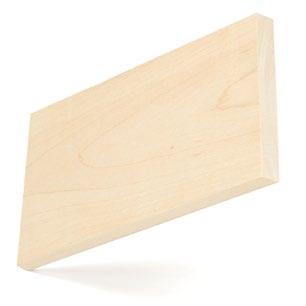
FIA data shows U.S. soft maple growing stock is 1.62 billionm3 , 11.1% of total U.S. hardwood growing stock. American soft maple is growing 36.4 million m3 per year while the harvest is 16.0 million m3 per year. The net volume (after harvest) is increasing 20.4 million m3 each year. U.S. soft maple growth exceeds harvest in all the main producing states.
GROWTH AND REMOVALS, MILLION M³ American soft maple forest volume
1.6 (billion)
U.S. forest volume
14.6 (billion)
MECHANICAL PROPERTIES
Soft maple has good bending and crushing strength, but is low in stiffness and shock resistance. It is about 25% less hard than hard maple. Accordingly it is not recommended for flooring or work tops.
0.54
Specific gravity (12% M.C.)
609 kg/m3
Average weight (12% M.C.)
10.5%
Average volume shrinkage (Green to 6% M.C.)
92.393 MPa
Modulus of rupture
11,308 MPa
Modulus of elasticity
45.093 MPa
Compressive strength (parallel to grain)
0.48
Specific gravity (12% M.C.)
545 kg/m3
Average weight (12% M.C.) 9.3%
Average volume shrinkage (Green to 6% M.C.)
4,226 N Hardness Acer macrophyllum
73.777 MPa
Modulus of rupture
9,998 MPa
Modulus of elasticity
41.025 MPa
Compressive strength (parallel to grain)
3,781 N Hardness
American hard maple, growing naturally in the hardwood forests of North America, is world-renowned for its delicate colour, hardness, fine grain and finishing quality.
LATIN NAME
Acer saccharum
OTHER COMMON NAMES
sugar maple, rock maple, black maple
WOOD DESCRIPTION
• The sapwood of hard maple is normally creamy white but can show a slight reddish/brown tinge. White sapwood lumber can be selected and veneer is always selected. The heartwood of hard maple varies in colour from light to dark reddish brown and may also vary according to region. The difference between heart and sap colour may only be slight. Both may contain pith fleck as a natural characteristic.
• The wood of hard maple has a close fine texture and is generally straight grained. Hard maple can occur as ‘curly’, ‘fiddleback’ and ‘birds eye’ figure which is highly prized. The wood darkens on exposure to light with time.
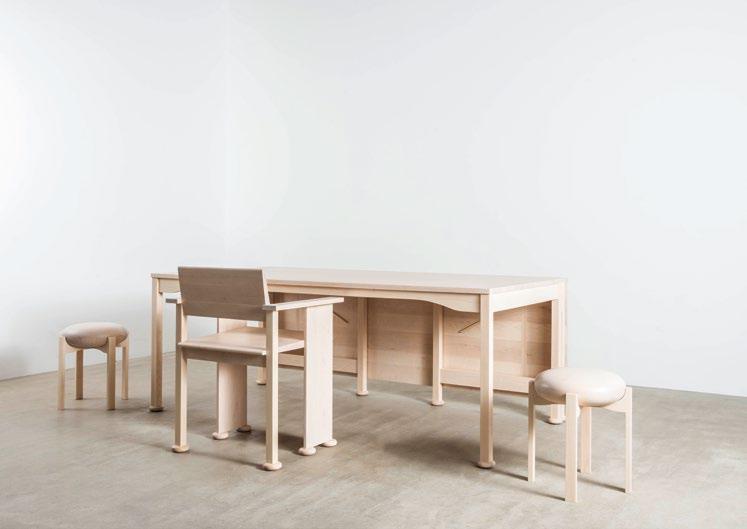
3.31 seconds
REGENERATION RATE
It takes 3.31 seconds to grow 1m³ of American hard maple
The replacement rate is calculated from total U.S. annual increment of the specified hardwood species derived from the U.S. Forest Service Inventory and Analysis (FIA) program and assumes that 2m³ of logs is harvested to produce 1m³ of lumber (i.e. 50% conversion efficiency). The rapid rate of replacement is due to the very large volume of hardwood trees in U.S. forest.
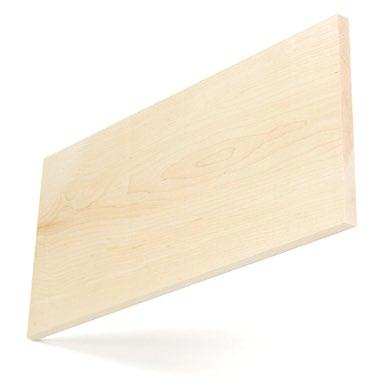
MECHANICAL PROPERTIES
Hard maple is hard, as the name suggests, and is heavy with good strength properties. It has high resistance to abrasion and wear as well as good steam bending properties. Accordingly, it is a preferred species for flooring, including sports floors, bowling alleys and worktops.
*Values for Acer saccharum
0.63
Specific gravity (12% M.C.)
705 kg/m3
Average weight (12% M.C.)
11.9%
Average volume shrinkage (Green to 6% M.C.)
108.941 MPa
Modulus of rupture
12,618 MPa
Modulus of elasticity
53.988 MPa
Compressive strength (parallel to grain)
6,450 N Hardness
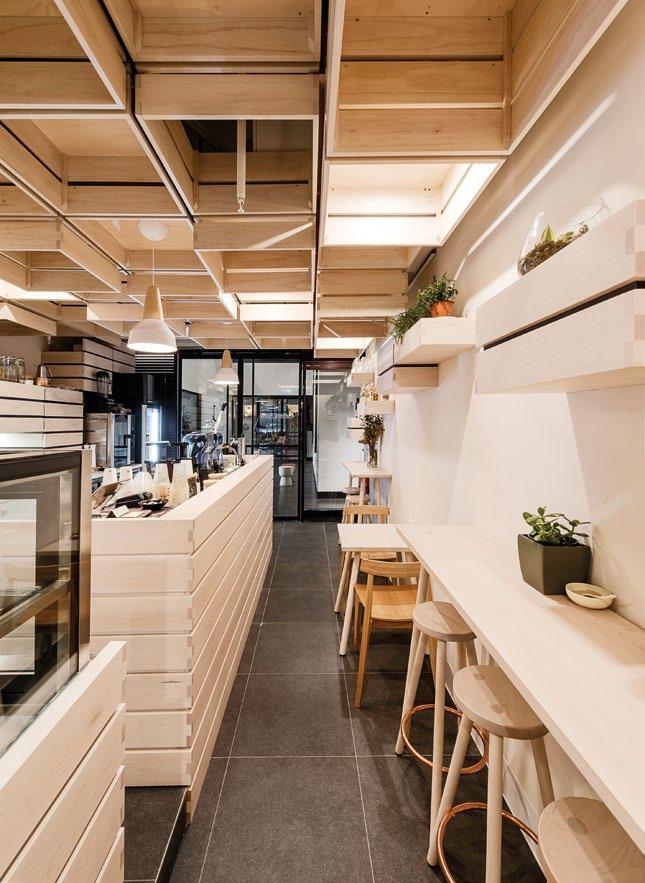
Hard maple from the USA is readily available as sawn lumber in a range of grades and sizes and as veneer. Lumber is regularly produced in 4/4" through to 8/4" but limited as thicker stock.
The lumber may be sold according to (white) colour selection, for which a premium is normally charged. This is usually done using the NHLA grading standard for colour sorting, producing colour grades such as “1&2 white”. Consultation with suppliers is recommended.
Volume of live trees on forest land, 1000m3
• Hard maple lumber is excellent to machine, bore, turn and finish. It glues, planes, drills and carves well but screwing and nailing is only fair. It produces good mouldings. Hard maple can easily be sanded, stained and polished to a very fine and smooth finish.
• The heartwood is only slightly or non-resistant to decay and the heartwood is resistant to preservative treatment. The sapwood is permeable.
This sustainably managed wood from natural forests of North America, with excellent environmental credentials, is revered worldwide for its hard-wearing property, delicate light colour and fine finish. It is highly suitable for all types of flooring, including high traffic areas such as public buildings, furniture, cabinet making and high-class joinery. It is widely used for table and work tops, mouldings, and kitchen cabinets.
Mouldings Flooring Furniture Cabinets Food Related Use
0
American hard maple is a cold climate species although, trees can grow throughout the USA in mixed hardwood forests but favour the more northern states. The species is quite different from other maples throughout the world. The trees often grow in dense stands on many types of soil and are also farmed for their famous maple syrup. Harvesting the trees is seasonal (autumn and winter).
FIA data shows U.S. hard maple growing stock is 955.4 million m3 , 6.5% of total U.S. hardwood growing stock. American hard maple is growing 19.1 million m3 per year while the harvest is 10.2 million m3 per year. Net volume (after harvest) is increasing 8.9 million m3 each year. U.S. hard maple growth exceeds harvest in all major supplying states except Maine. In Maine maple harvests have been high relative to growth, mainly due to increased extraction for pulpwood and bioenergy supplies, and because mapledominated hardwood forests are slowly being replaced by softwood forest types.
AND REMOVALS, MILLION M³ American hard maple forest volume
955.4 (million)
U.S. forest volume 14.6 (billion)

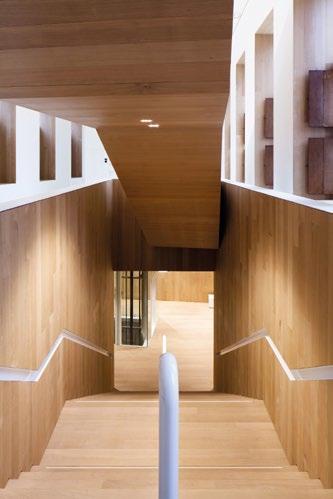
 The Apex multi-function hall in American white oak by Hopkins Architects
Mechelen Museum in American white oak by dmvA Architects
The Apex multi-function hall in American white oak by Hopkins Architects
Mechelen Museum in American white oak by dmvA Architects
“What I
love
about cherry
is its combination of strength and lightness. It's a relatively light hardwood, but it’s still strong and has a beautiful tight grain that’s smooth to the touch.
I find it calming.”
– Alison Brooks, Principal& Creative Director of
Alison Brooks Architects


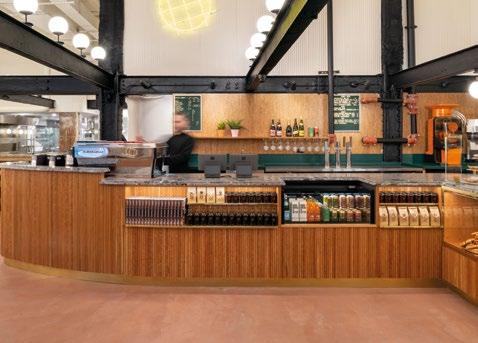
 Essay 4 in American red oak by Mandana Architects
Worth Abbey in American walnut by Thomas Heatherwick
Tsi Ming Temple in American hard maple by Archoffice Architects
Essay 4 in American red oak by Mandana Architects
Worth Abbey in American walnut by Thomas Heatherwick
Tsi Ming Temple in American hard maple by Archoffice Architects
American walnut is one of the most sought-after species in markets across the world and is unique to North America.
LATIN NAME
Juglans nigra
OTHER COMMON NAMES
black walnut
WOOD DESCRIPTION
• The sapwood of walnut is creamy white, whereas the heartwood is light brown to dark chocolate brown, making the difference in colour quite distinct. Occasionally the heartwood has dark, even purple, streaks. The wood of walnut is generally straight grained, although sometimes with wavy or curly grain that produces its characteristic and attractive figure, sought after by designers.
• American walnut is a different species to European walnut, which tends to be lighter in colour.
 Linbury Theatre, The Royal Opera House, by Stanton Williams
Linbury Theatre, The Royal Opera House, by Stanton Williams
13.09 seconds
REGENERATION RATE
It takes 13.09 seconds to grow 1m³ of American walnut
The replacement rate is calculated from total U.S. annual increment of the specified hardwood species derived from the U.S. Forest Service Inventory and Analysis (FIA) program and assumes that 2m³ of logs is harvested to produce 1m³ of lumber (i.e. 50% conversion efficiency). The rate of replacement is due to the volume of hardwood trees in U.S. forest.
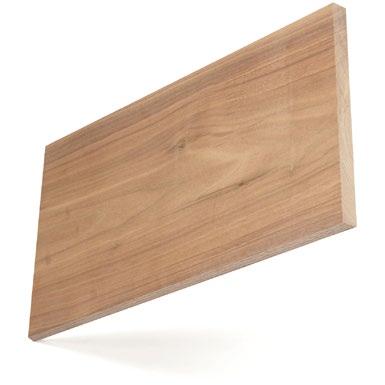
MECHANICAL PROPERTIES
Walnut is tough, hard and of medium density. It has moderate bending and crushing strengths and is low in stiffness. It has good steam bending classification.
0.55
Specific gravity (12% M.C.)
609 kg/m3
Average weight (12% M.C.)
10.2%
Average volume shrinkage (Green to 6% M.C.)
100.677 MPa
Modulus of rupture
11,584 MPa
Modulus of elasticity
52.264 MPa
Compressive strength (parallel to grain)
4,492 N Hardness

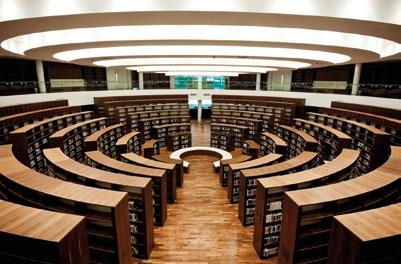

Walnut from the USA is available as sawn lumber and as veneer. The lumber is generally sold un-steamed and unselected for colour. Specialist producers may offer steamed walnut intended to darken the sapwood and thus reduce the colour difference between heartwood and sapwood. Recent years have seen huge global demand for this species. NHLA Grading Rules are modified for walnut, allowing smaller specifications and smaller clear cuttings. Sapwood is admitted without limit. Consultation with suppliers is recommended.
Volume of live trees on forest land, 1000m3
• American walnut works easily with hand and machine tools. It has excellent planing, turning and moulding properties. It has good nailing and gluing properties and can be stained and polished to an excellent finish. The wood dries slowly and has good dimensional stability when dry.
• The wood is rated as very resistant to heartwood decay and is one of the most durable (decay resistant) American hardwoods.
Walnut is considered one of the supreme species for high end furniture, cabinets, doors and interior joinery. It is used for flooring and panelling and sometimes to contrast with other lighter colour hardwoods.
Flooring Furniture Doors Panelling Cabinets
FIA data shows U.S. walnut growing stock is 139.3 millionm3 , 1.0% of total U.S. hardwood growing stock. American walnut is growing 4.8 million m3 per year while the harvest is 1.9 million m3 per year. The net volume (after harvest) is increasing 2.9 million m3 each year. U.S. walnut growth exceeds harvest in all major supplying states except Michigan.
American walnut trees grow very widely across the eastern USA in mixed hardwood forests and on farms, concentrated in central states but spread from Texas to the eastern seaboard. The trees are one of the few hardwood species planted as well as regenerating naturally. They grow relatively tall and straight with few lower branches, which limits the occurrence of knots in the lumber.
Thermally Modified Timber (TMT) is not a new concept. The ancient Vikings knew that when building defensive fencing for fortifications, poles made from timber with a burnt surface lasted longer than those that hadn’t. More modern studies on possible benefits of TMT began in the 1930s and ’40s in Europe and the USA but the technology was not developed commercially. It wasn’t until the late 1990s that Scandinavia first introduced the commercial method of thermal modification that we recognise today, as a way of improving the durability and stability of native softwoods. More recent experimental and development work has shown that the thermal modification process works extremely well with some North American hardwood species. Commercial TMT kilns were first introduced into North America in the mid 2000s.
The TMT process is essentially a high intensity kiln schedule that lasts between 3 to 4 days depending on species and dimension of timber. The temperature reaches between 180 and 215 degrees C depending on the level of durability required. The process requires an inert atmosphere devoid of oxygen to prevent combustion, this is usually either steam or a vacuum. During the process, the chemical and physical properties of the timber undergo permanent change.
The two most beneficial effects of the TMT process are to dramatically improve the stability and also the durability of timber species that have an inherently low natural durability, such as ash and tulipwood. After the process, the moisture content is lowered to around 4 – 6%, the equilibrium moisture content is permanently reduced which means that thermally modified timber is less affected by atmospheric changes in humidity, reducing the ability of the timber to absorb moisture, and so greatly improving its stability properties.
The durability is improved by removing the hemicelluloses and carbohydrates from the wood which are the main food sources for wood-destroying fungi. Independent durability testing conducted at CATAS in Italy has shown that the durability of four North American hardwood species, ash, tulipwood, soft maple, and quarter sawn red oak, can be improved by thermal modification to achieve durability rating class 1 (very durable) according to EN 350:2016. This is the highest rating possible and equal to that of tropical timber species such as Ipe. This now means that these species can be used for exterior applications such as cladding, decking and exterior products such as garden furniture.
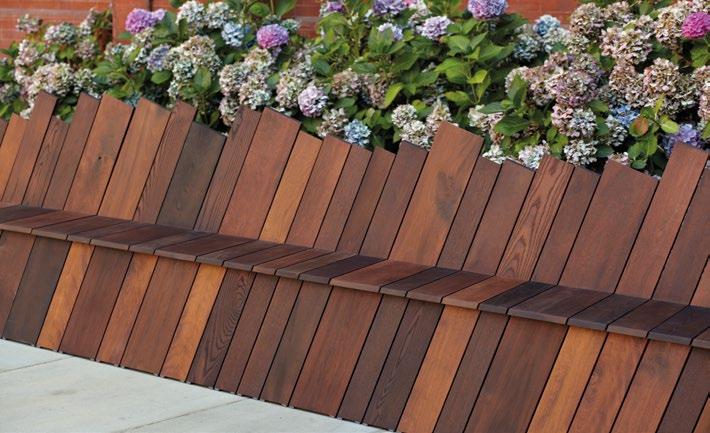

Other benefits include a reduction in thermal conductivity by around 20 – 25% compared to its untreated state, a significant benefit for window manufacturers. It also appears to improve the surface hardness of some species although more research is needed to fully quantify which species and by how much.
The other characteristic of TMT is a change in appearance leading to darker colour tones, the degree to which the timber darkens is influenced by temperature and species. AHEC experimental projects with designers and architects have shown that thermally modified American hardwoods machine extremely well, producing high quality smooth finishes that often don’t require further finishing.
Thermally modified American hardwoods now offer a real alternative to traditional preservative treated timber for most external applications. There are no special handling precautions required with TMT and there are no environmental issues associated with wood disposal, or issues of leaching of chemicals whilst the timber is in service. Another important factor is that when using American hardwoods markets can be assured of their sustainability and legality credentials.

Although the thermal modification process has been shown to impact on some aspects of timber strength, such as bending, it should be noted that many hardwoods are inherently stronger than most softwoods traditionally used for construction. However, until more data is available, their use for major structural applications is not recommended. But AHEC projects demonstrate that successful engineering of TMT American hardwoods by finger jointing and glue lamination is still possible. As a general rule, the thermal modification process is not suitable for thicknesses of lumber over 50mm.
There are now around 120 commercial TMT operations worldwide, nearly 100 of which are in Europe and about 10 in the U.S.A and some in Asia. Thermally modified American hardwoods can be sourced from a number of specialist producers and exporters in the USA as well as from treatment companies in Europe, and elsewhere.
Paul’s shed by Nathalie de Leval for Paul Smith, made with TMT ash as part of The Wish ListAmerican hickory and pecan are different species of a very diverse group, but in the round (log) they are virtually indistinguishable from each other and therefore often processed by saw mills and the lumber sold mixed together.
Hickory and pecan sawn lumber is readily available in export grades, but sold unselected for colour and mixed. The NHLA FAS grade permits a minimum width of 4 inches (101.6mm). The lower NHLA grades (1 & 2 Common) can produce an attractive and fashionable rustic look. Lumber is mainly produced in thinner stock (4/4" & 5/4") although a limited amount of thicker material may be available.
The hickories are an important group and the trees grow naturally throughout the Eastern U.S., from north to south. They are split into two groups; the more important true hickories and hickories producing pecan nuts, the latter being an important fruit-bearing tree. Fruit-bearing pecan trees grow naturally in the south eastern USA and principally in the Mississippi valley. Trees vary in size enormously.
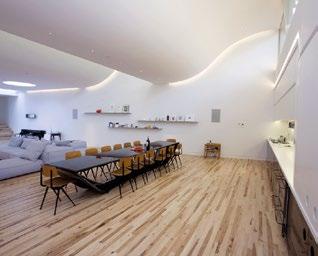
The wood of hickory and pecan varies greatly in colour, grain pattern and appearance from this very diverse group. Hickory tends to be fine textured, pecan is coarser, and the grain is usually straight but can be wavy or irregular. The sapwood is white and maybe tinged with brown, while the heartwood is pale to yellow brown to dark in colour. Deep purple mineral streaks are a natural characteristic. Bird pecks are also a common characteristic and neither is considered a defect.
• Hickory is considered difficult to machine and glue. Pecan is considered easier to machine but both are very hard to work with hand tools. They will hold nails and screws well but tends to split so pre-boring is advised. The wood can be sanded, stained and polished to a good finish. It can be readily dried but has fairly high shrinkage, which may affect stability under variable moisture conditions and in wider width material.
• The wood is non-resistant to heartwood decay and classed as moderately resistant to preservative treatment.
Furniture, cabinetry, ladders, striking tool handles dowels and sporting goods. Traditionally used by wheelwrights and for making drumsticks. The hardwearing properties of hickory make it an excellent choice for flooring, especially in situations of high traffic use. Historically the first wooden golf club shafts were made from hickory, and NHLA lumber graders still use the traditional flexible hickory measuring stick.
LATIN NAME
Carya species
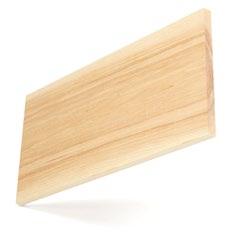
FIA data shows U.S. hickory growing stock is 742.3 million m3 , 5.1% of total U.S. hardwood growing stock. American hickory is growing 14.6 million m3 per year while the harvest is 6.0 million m3 per year. The net volume (after harvest) is increasing 8.6 million m3 each year. U.S. hickory growth exceeds harvest in all significant producing states with the exception of Louisiana.
MECHANICAL PROPERTIES
The wood of hickories is rather coarse and varies from strong to less strong but is heavy and very hard. It has good bending strength, shock resistance and excellent steam bending properties.
Carya glabra
0.75
Specific gravity (12% M.C.)
833 kg/m3
Average weight (12% M.C.)
14.3%
Average volume shrinkage (Green to 6% M.C.)
138.590 MPa
Modulus of rupture
15,583 MPa
Modulus of elasticity
63.365 MPa
Compressive strength (parallel to grain)
N/A Hardness
LATIN NAME
Carya species

FIA data shows U.S. pecan growing stock is 46.8 million m3 , 0.3% of total U.S. hardwood growing stock. American pecan is growing 931,000 m3 per year while the harvest is 355,000 m3 per year. The net volume (after harvest) is increasing 576,000 m3 each year. U.S. pecan growth considerably exceeds harvest in the four main producing states of Arkansas, Kansas, Louisiana, and Mississippi.
MECHANICAL PROPERTIES
The wood of pecan is usually considered very strong with excellent stem bending classification, high crushing strength, high stiffness and very high shock resistance.
Carya illinoensis
0.66
Specific gravity (12% M.C.)
737 kg/m3
Average weight (12% M.C.)
N/A
Average volume shrinkage (Green to 6% M.C.)
94.462 MPa
Modulus of rupture
11,928 MPa
Modulus of elasticity
54.126 MPa
Compressive strength (parallel to grain)
8,095 N Hardness
American elm is a survivor of the Dutch elm disease which devastated elm populations elsewhere in the world.
Elm from the USA is available in very limited commercial volumes and sawn lumber is produced mainly in 4/4" (25.4mm) thickness. As a result, specifications and grades for export may be difficult to source on a regular basis. Veneer may also be available from specialist suppliers.
American red elm trees are now naturally regenerating in some regions making supplies patchy. Distribution is widespread but trees are greatly influenced by site conditions. Trees are relatively small, often with divided trunks.
The close grain red elm may be straight or severely interlocked, with a coarse texture. The narrow sap is greyish white to light brown and the heartwood is light to dark brown in colour. Bird pecks are found in elm and are regarded as a natural characteristic and not considered a defect under NHLA Grading Rules.

LATIN NAME
Ulmus rubra
OTHER COMMON NAMES
slippery elm, brown elm, grey elm, red elm
• Elm machines fairly well and it nails and screws easily. It glues well and can be sanded, stained and polished to a good finish. It dries well with minimum degrade and has little movement in performance.
• The wood is rated non-resistant to heartwood decay but is classed as permeable to preservatives.
American elm, when it is available, is an attractive and desirable species for furniture and cabinet making and can also be used for internal joinery, flooring and panelling.
Flooring Furniture Panelling Cabinets
FIA data shows U.S. elm growing stock is 297.6 million m3 , 2.0% of total U.S. hardwood growing stock. American elm is growing 5.9 million m3 per year while the harvest is 2.5 million m3 per year. The net volume (after harvest) is increasing by 3.4 million m3 each year. U.S. elm growth exceeds harvest in most significant producing states with the exception of Ohio. Despite surviving Dutch elm disease American elm is still susceptible to the disease which has impacted on growth and harvest in some States.
American sycamore is one of the few wood species that can be confused with its European cousin Acer pseudoplatnus, which is botanically different.
Sycamore lumber from the USA is available in limited volumes mainly from southern producers and more easily sourced as thinner stock (4/4" & 5/4"). Check with suppliers for grades available for export. Veneer is also available from specialist suppliers.
American sycamore trees are generally huge, being one of the largest hardwood species in North America, growing throughout the eastern and central USA in natural hardwood forests. Several other American planes, as they are called, grow in California and Arizona but are not commercially significant.
The wood of sycamore may display a variety of colours. The sap is white to light yellow in colour and the heartwood is light to dark brown. Sycamore has a fine close texture and is interlocked. The grain is distinct with a characteristic fleck.

LATIN NAME
Platanus occidentalis
OTHER COMMON NAMES
buttonwood, American plane
• Sycamore machines and works well, but high speed cutters are required to avoid chipping. It is resistant to splitting due to its interlocked grain. The wood glues well and stains and polishes with care to an excellent finish. It dries rapidly and has a tendency to warp. It has moderate shrinkage and little movement in performance.
• The wood is non-resistant to heartwood decay but is permeable to preservative treatment.
American sycamore, growing in natural forests in the USA, is considered highly suitable for cabinetry and furniture. It is used for mouldings, internal joinery and veneered panels. Specialist uses include butcher blocks and shopfitting.
Mouldings Furniture Cabinets Veneered Panels Food Related Use
FIA data shows sycamore growing stock in the U.S. (excluding California and Arizona) is 144.5 million m3 , 1% of total U.S. hardwood growing stock. American sycamore is growing 4.00 million m3 per year while the harvest is 1.22 million m3 per year. The net volume (after harvest) is increasing 2.78 million m3 each year. U.S. sycamore growth exceeds harvest in all supplying states.
American basswood is a light weight species renowned for its creamy colour and ability to be machined and shaped accurately into thin sections, and as a premium wood for carving.
Basswood from the USA is available in relatively limited volumes compared to some other species, both as sawn lumber and veneer. Lumber is available in a range of grades and thickness from 4/4" (25.4mm) right through to 16/4" (101.6mm) due to its ease of drying. Basswood lumber is also available in 9/4" (57.2mm) a specially produced thickness for production of window shutters and venetian blinds.
American basswood is botanically related to the lime tree found in Europe. The trees are generally large in height and diameter, often with straight trunks and relatively free of limbs thus reducing knots. Basswood can be found growing throughout the USA in natural hardwood forests.

Tilia americana
linden
The sap of basswood tends to be large and is creamy white in colour giving way to the heartwood that is pale to reddish brown. It may display dark streaks which are not a defect. The difference between sap and heartwood is small and may be indistinct. The wood of basswood has a fine uniform texture and straight grain, which is not distinct.
• Basswood machines easily and works well with hand tools, making it a preferred species for carving. It holds screws better than nails, and glues reasonably well and can be sanded, stained and polished to a good smooth finish. It dries fast with low degrade and has good dimensional stability when dry.
• The wood is non-resistant to heartwood decay but is permeable, which makes it possible to accept preservative treatment and staining.
This unique hardwood, growing in natural forests in the USA, is considered the best species for venetian blinds and internal shutters. It is widely used for carving, turning, mouldings and furniture. Specialist uses include pattern making and musical instruments, especially for piano parts.
Mouldings Carving Furniture Musical Instruments Turning
Forest Inventory Analysis (FIA) data shows U.S. basswood growing stock is 210.9 million m3 , 1.4% of total U.S. hardwood growing stock. American basswood is growing 3.3 million m3 per year while the harvest is 1.7 million m3 per year. The net volume (after harvest) is increasing by 1.6 million m3 each year. U.S. basswood growth exceeds or is in balance with harvest in all the main producing states.
American eastern cottonwood is one of many true poplars, such as aspen, but requires expertise to use successfully.
American cottonwood is available as sawn lumber and veneer but may only be available in limited volumes of export specifications, determined by current export demand. Cottonwood lumber is mainly available from southern producers predominantly in 4/4" (25.4mm) and 5/4" (31.8mm), where it needs to be processed quickly when freshly cut (green) to avoid checking and blue staining.
American eastern cottonwood trees are fast growing and the largest of this genus grows widely across the USA and is normally associated with water such as the Mississippi. They can be up to 8 feet in diameter. Cottonwood may be referred to as white poplar and should not be confused with tulipwood, known as yellow poplar in the USA.

Populus deltoides
OTHER COMMON NAMES
eastern cottonwood, eastern poplar
Cottonwood is a porous wood with a coarse texture. It is generally straight grained with relatively few defects. The sap is white, but may contain brown streaks. The heartwood is pale to light brown.
• Cottonwood presents some machining challenges, which can be overcome. The wood may produce a fuzzy or woolly surface when cut, so it is essential to use sharp blades set at the correct angle to avoid this problem. Otherwise it glues and screws well without splitting. It dries easily but with a tendency to warp, with small movement in performance.
• The wood is non-resistant to decay.
Traditionally used for venetian blinds, American cottonwood is used for furniture, especially reproduction furniture and furniture parts. Other uses include internal joinery and mouldings.
Mouldings Furniture Cabinets
FIA data shows U.S. cottonwood growing stock is 236.5 million m3 , 1.6% of total U.S. hardwood growing stock. U.S. cottonwood is growing 4.3 million m3 per year while the harvest is 1.8 million m3 per year. The net volume (after harvest) is increasing 2.5 million m3 each year. American cottonwood growth exceeds harvest in all the main producing states except Maine (where it is mainly planted in urban areas), Nebraska and Texas. Cottonwoods are declining in some semi-arid areas of the U.S. due to drought, invasion of exotic species and overgrazing.
American gum is an important and diverse group of hardwoods, often undervalued and growing sustainably throughout the eastern and particularly the south-eastern USA. Not to be confused with Australian gum (Eucalypt).
American gum is available as sawn lumber and veneer in a variety of grades and sizes. It is usually sold as sapgum with no colour specification. Under NHLA Grading Rules each clear cutting must have one red (heartwood) face. When sorted for colour redgum (majority heartwood) is much more limited in availability. Lumber is more likely to be available in thinner stock (4/4" & 5/4") and may be more limited in export markets.
American gum trees are large with straight trunks growing widely across the South Eastern USA. There are several other, non-commercial, gums that also grow across the USA.
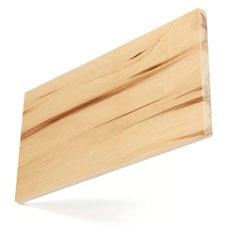
Liquidambar styraciflua
OTHER COMMON NAMES
redgum, sweetgum
Gum has a fine uniform texture, but has irregular grain, usually interlocked, often with an attractive grain figure. The sap of gum tends to be wide and is white to light pink in colour, whereas the heartwood is reddish brown, typically with dark streaks.
• Gum is easy to work with both hand and machine tools. It nails, screws and glues well, takes stain easily and can be sanded and polished to an excellent finish. Gum dries rapidly with a strong tendency to warp and twist. It has a large shrinkage and is liable to movement in performance.
• The wood is rated as non-resistant to decay. The heartwood is moderately resistant to preservative treatment, but the sap is permeable.
Main uses are cabinet making, furniture and furniture parts, doors, internal joinery and mouldings. Gum has been used and stained, as a substitute for walnut or mahogany.
Mouldings Furniture Doors Cabinets
FIA data shows U.S. gum growing stock is 714.6 million m3 , 4.9% of total U.S. hardwood growing stock. American gum is growing 22.9 million m3 per year while the harvest is 11.7 million m3 per year. The net volume (after harvest) is increasing 11.2 million m3 each year. U.S. gum growth exceeds or is in balance with harvest in all the main producing states.
American yellow birch is one of a large group of species and is commercially the best of its group grown sustainably with a wide distribution, preferring cool regions with high rainfall.
Birch from the USA is available in limited volumes as sawn lumber unselected for colour but more limited in sizes and grades if red heartwood or white sapwood is specified. When selected for colour FAS grade will allow 5 inch minimum width. Refer to NHLA Grading Rules for colour sorting specifications. Birch is more likely to be available in thinner sizes 4/4" (25.4mm) & 5/4" (31.8mm). Veneer may also be available from specialist suppliers.
American yellow birch trees are generally not too large in this pioneer species that can be overgrown by climax species, such as maple. Definitely a northern, cold climate tree, yellow birch is medium sized with a medium diameter although larger trees can grow infrequently. Yellow birch should not be confused with paper birch, which is softer in texture and lighter in colour with scattered brown flecks.
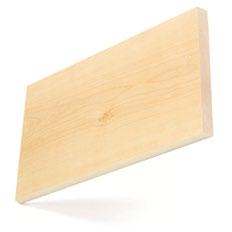
LATIN NAME
Betula alleghaniensis
OTHER COMMON NAMES
N/A
The wood of yellow birch has a distinct difference between the sap which is white and the heartwood which is light reddish brown. The wood is generally straight grained with a fine uniform texture.
• Birch machines fairly easily and works well with care, including turning and takes stains and polish extremely well. It nails and screws satisfactorily where pre-boring is recommended. It dries rather slowly with little degrade, but has a moderately high shrinkage, so may move in performance.
• The wood is non-resistant to heartwood decay but is moderately resistance to preservative treatment and the sapwood is permeable.
American yellow birch, growing sustainably in the natural forests in the USA, is used for some furniture and joinery, such as doors and interior panelling and kitchen cabinets.
Furniture Panelling Cabinets
Forest Inventory Analysis (FIA) data shows U.S. yellow birch growing stock is 541 million m3 , 3.7% of total U.S. hardwood growing stock. American yellow birch is growing 7.1 million m3 per year while the harvest is 4.8 million m3 per year. The net volume (after harvest) is increasing 2.3 million m3 each year. U.S. yellow birch growth exceeds harvest in most of the main producing states including Maine, New Hampshire, New York, Pennsylvania and Vermont.

“Wood has so many different qualities if you can use it well, including its ability to capture carbon. What better core material could there be for something like this in people’s homes?” – Thomas Heatherwick


 OVO furniture range in American walnut by Foster + Partners, crafted by Benchmark Furniture
The Sun Lounge in thermally modified American red oak by Jarrod Lim
OVO furniture range in American walnut by Foster + Partners, crafted by Benchmark Furniture
The Sun Lounge in thermally modified American red oak by Jarrod Lim
“Maple is a strong reliable wood, both in terms of its mechanical properties and its aesthetic. It’s very light and white and can almost disappear in a space and blend in with the surroundings.” – Maria Bruun
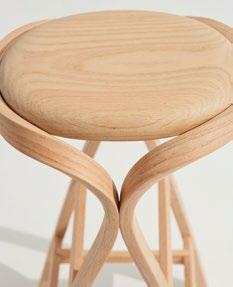

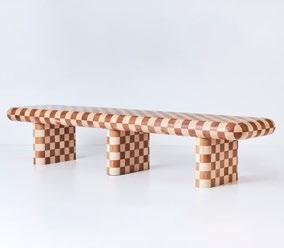
 Taburete Barlovento in American red oak by Andrés Mariño Maza as part of Toca Madera
Stammtisch in American red oak by Sebastian Herkner, as part of Connected
The Blushing Bar in American red oak by Sebastian Cox and Chan + Eayres
Taburete Barlovento in American red oak by Andrés Mariño Maza as part of Toca Madera
Stammtisch in American red oak by Sebastian Herkner, as part of Connected
The Blushing Bar in American red oak by Sebastian Cox and Chan + Eayres
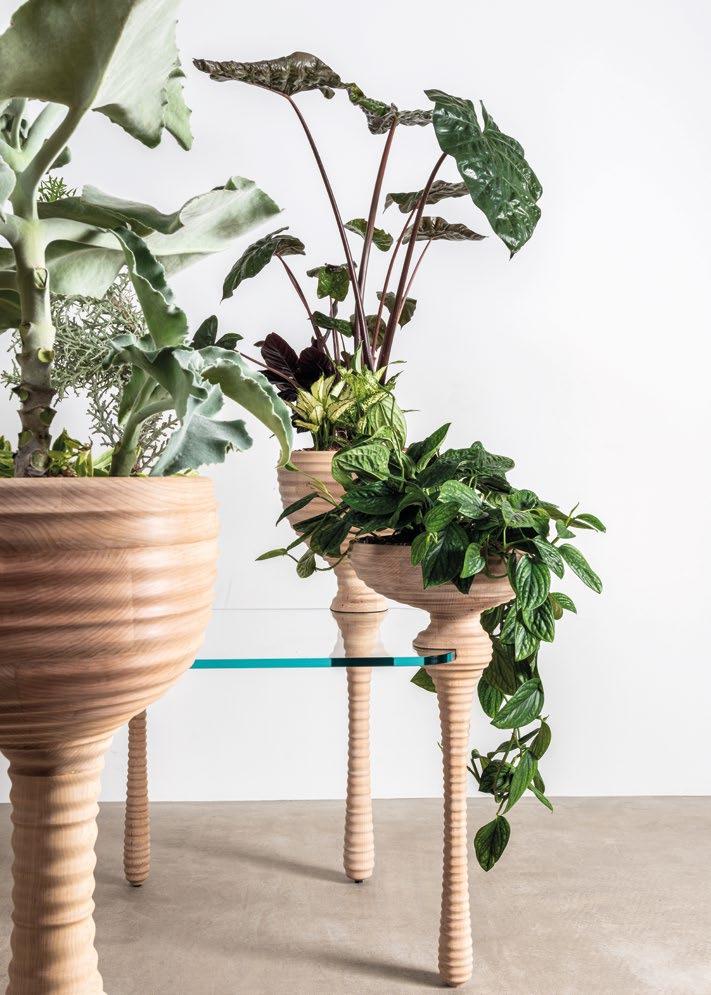
American alder is the major commercial species grown on the western seaboard of the USA and is unique to the hardwood forest resources of North America; one of the few red hardwood species.
• Alder is graded using NHLA Pacific Coast Red Alder Rules published in the “NHLA Rules for the Measurement and Inspection of Hardwood and Cypress”. The key grading points include grading from the better face rather than poor side, as in the Standard NHLA Grading Rules; pin knots are regarded as character and no defect. The primary grades include Superior (Select and Better), Cabinet (No. 1 Common) and Frame (No. 2 Common) that are similar to uses as for the standard NHLA grades.
• Alder from the USA is readily available as kiln dried sawn lumber and often sold under a range of unique grading rules, for grades not listed in the NHLA Rules, consultation with suppliers is recommended.
• Lumber may be sold rough sawn or planed as dimension stock. It has limited availability as veneer.
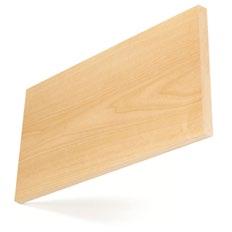
LATIN NAME
Alnus rubra
OTHER COMMON NAMES
red alder, western red alder, western alder
Alder is almost white when freshly cut, but quickly changes on exposure to air, becoming light brown with a yellow or reddish tinge. There is no visible difference between the sap and the heartwood, although heartwood is formed only in older or mature trees. The wood of alder is fairly straight grain, somewhat similar in character to cherry, with uniform texture.
American alder trees grow prolifically in the Pacific Northwest under sustainable management. Alder has a relatively short rotation, taking less time to mature for harvest than most other hardwoods.
• Alder machines easily and is good for planing, drilling, boring, carving, moulding, nailing, screwing and gluing, making it highly suitable for furniture and joinery.
• The wood is non-resistant to heartwood decay but is permeable to preservative treatment.
• This prolific hardwood from the Pacific Northwest, with excellent environmental credentials, is used for furniture, kitchen cabinets and interior joinery. It is also used for doors and panelling.
• The grain pattern and colour of alder makes it suitable as a substitute for cherry.
Furniture Doors Panelling Cabinets
American aspen is a true poplar, growing widely in the USA, particularly in the Northeast, Lake States and across to the Rockies. The genus Populus is composed of many species, which all look alike microscopically. However, aspen is completely different to tulipwood, often referred to as yellow poplar in the USA despite not being a Populus.
Aspen from the USA is available as sawn lumber and veneer. Lumber tends to be available mainly in thinner sizes, 4/4" (1" or 25.4mm) and 5/4" (1.25" or 31.8mm), although limited volumes of 6/4" (38.1mm) and 8/4" 50.8mm may be available from some suppliers.
American aspen trees grow in dense stands that are easily sustainable but are commercially less important than some other American hardwoods. Trees can grow up to 120ft (48m) and up to 4ft (1.2m) in diameter. Due to genetic variability trunks can either be quite cylindrical with little taper and few limbs, or crooked and contorted. Aspen is one of the species that benefits from clear-cutting to regenerate, being shade intolerant, and regrows both from seedlings and root suckers. It is a natural pioneer species after forest fires. The four main aspen producing states are Minnesota, Wisconsin, Maine and Michigan.
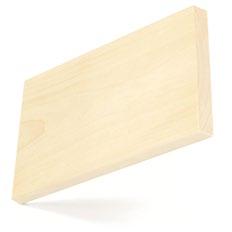
Populus tremuloides
OTHER COMMON NAMES
white poplar, trembling aspen, popple
The sap of aspen is white and the heartwood is light brown with only a small difference between the two. The wood of aspen has a fine uniform texture and straight grain.
• Aspen machines easily but can produce a slightly fuzzy surface when cut. It does not split when nailed and it turns and sands fairly easily and holds paint and stain well to produce a good finish, but care is needed where the surface is fuzzy. Aspen has low to moderate shrinkage and good dimensional stability. It is similar in performance to other true poplars grown around the world.
• The wood is non-resistant to heartwood decay and is resistant to preservative treatment.
This fast growing hardwood, which is common across the USA, is used for furniture parts, particularly drawer sides. It is also used in a variety of applications including doors, interior joinery, mouldings and picture frames. Specialist uses include seating in saunas due to its low conductivity of heat and in food packaging and chopsticks due to lack of odour and taste. Aspen is also used for pulp for paper.
Mouldings Doors Cabinets
Forest Inventory Analysis (FIA) data shows U.S. aspen growing stock is 637.1 million m3 , 4.4% of total U.S. hardwood growing stock. American aspen is growing 10.4 million m3 per year while the harvest is 8.9 million m3 per year. The net volume (after harvest) is increasing 1.5 million m3 each year.
American black willow is a southern states species, usually associated with water and is just one of many willow species.
WOOD DESCRIPTION
The wood of willow has a fine and even texture. The grain may be straight or interlocked and may present attractive figure. The narrow sapwood varies according to site conditions and is light to creamy brown in colour but can be almost white. The heartwood is distinct ranging from pale reddish brown to greyish brown and can be quite dark. Burls and swirls in the grain are natural characteristics and are not considered defects.
American sassafras is a medium sized tree important to wildlife and the perfume industry because of its aromatic properties. It is used for furniture and joinery but is not widely exported as lumber due to its limited availability.
WOOD DESCRIPTION
The heartwood of sassafras is pale to dark brown but often golden in colour. It is a soft light flexible wood. The grain may be interlocked, can be straight but is often wavy and can produce a highly attractive fiddleback pattern. The wood may have a coarse or fairly fine texture and the grain has an ash-like appearance and resembles chestnut.
LATIN NAME
Salix nigra
OTHER COMMON NAMES
black willow, swamp willow
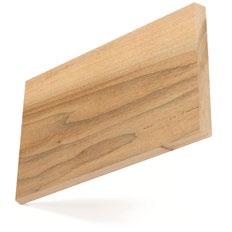
LATIN NAME
Sassafras officinale
OTHER COMMON NAMES
red sassafras, golden elm, cinnamon wood
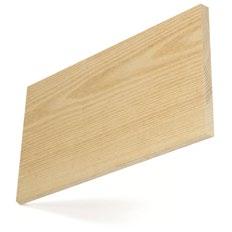
American hackberry is an attractive American hardwood, relatively unknown outside the USA.
WOOD DESCRIPTION
The wood of hackberry is similar to elm to which it is related, but although it is heavy is fairly soft and not very strong. The irregular coarse grain may be straight and sometimes interlocked, but it has a fine uniform texture. There is little difference between the sap and the heartwood which are yellowish grey to light brown in colour throughout.
American beech is an important species within the huge family of Fagaceae in the silvicultural composition of the natural hardwood forests of North America which include oaks and chestnut, but beech is not one of the most commercially available.
WOOD DESCRIPTION
American beech tends to be darker in colour and less consistent than European beech. The sapwood is almost white with a red tinge and the heartwood is light to dark reddish brown. The wood of beech is generally straight and close grained with uniform texture. It has medium bending and crushing strength, but is low in stiffness and shock resistance. The wood may exhibit brown mineral streaks in the heartwood which, under NHLA Grading Rules, are not considered a defect.
LATIN NAME
Celtis occidentalis
OTHER COMMON NAMES
sugarberry

LATIN NAME
Fagus grandifolia
OTHER COMMON NAMES
N/A
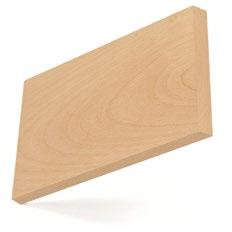

The purpose of this section is to provide a simplified but thorough explanation of the grading rules for American hardwood lumber. They were established 125 years ago by the newly formed National Hardwood Lumber Association (NHLA). Today the NHLA has over 650 members worldwide and the NHLA rules are still the national standard for the U.S. hardwood industry and form the basis for grading of export lumber.
Wood is a natural material and by its very nature may contain different characteristics and defects that need to be understood and considered in any given application. The grading of sawn wood into categories as it is processed helps to indicate, to a large extent, the value and potential use for each board of sawn lumber.
The NHLA grading rules provide both the buyer and seller with a consistent language to use in specifying hardwood lumber transactions. Although the NHLA grading rules are targeted for the U.S. marketplace, reasonable knowledge is essential for buyers worldwide in order to attain their expected degree of quality and yield.
The grade of lumber purchased by a manufacturer will determine both the cost and waste factor that is achieved. Because the grades are based on the percentage of clear wood in the board. Many of the beautiful, natural characteristics found in hardwoods are not considered in calculating the clear yield. This fact is highlighted by photograph illustrations of the main grades, for nine important U.S. hardwood species, contained in this publication.
Hardwood lumber is usually graded on the basis of the size and number of cuttings (pieces) that can be obtained from a board when it is cut up and used in the manufacture of a hardwood product. The NHLA rules were designed with the furniture trade in mind to provide a measurable percentage of clear, defect free wood for each grade. The upper grades provide the user with long clear pieces, while the Common grades are designed to be re-sawn into shorter clear pieces.
The upper grades, which will include FAS, FASOne-Face (FAS/1F) and Selects, are most suitable for long clear mouldings, joinery products such as door frames, architectural interiors; and furniture applications, which require a heavy percentage of long wide cuttings.
The Common grades, primarily Number 1 Common (No. 1C) and Number 2A Common (No. 2AC) are likely to be most suitable for the kitchen cabinet industry, most furniture parts, and plank and strip flooring. Worth noting is the fact that once re-sawn, the cuttings obtained from the Common grades will be the same clear wood as the upper grades but in smaller (shorter and/or narrower) cuttings. The grade name simply designates the percentage of clear wood in the board, not the overall appearance.
The American hardwood temperate forest resource is the largest of its kind anywhere in the world, with a significant history of sustainability. Exploring the Common grades, where possible, is invaluable in achieving the most value both in lumber cost and yield. These efforts will also help to ensure the sustainability of the resource for generations.
The NHLA lumber grading rules adopted by the U.S. hardwood industry are based on an imperial measurement system using inches and feet. In contrast, most export markets are more familiar with a metric standard. Additionally, the grade rules were developed with random width and length lumber in mind. Any selection for particular specifications should be discussed prior to ordering.
A board foot (BF) is the unit of measurement for hardwood lumber.
A board foot is 1 foot long × 1 foot wide × 1 inch thick.
(1 foot = 0.305 metres, 1 inch = 25.4mm)
The formula for determining board feet in a board is:
L D (width in inches) (length in feet) (thickness in inches) × ×
= BF
The percentages of clear wood required for each grade are based on this 12' unit of measure.
Surface measure (SM) is the surface area of a board in square feet. To determine surface measure, multiply the width of the board in inches by the length of the board in feet and divide the sum by 12, rounding up or down to the nearest whole number. The percentage of clear wood required for each grade is based on the surface measure, not the board feet, and because of this all boards, no matter what the thickness, are graded in the same way.
EXAMPLE OF SM AND BF:
The board below is a 2" thick, 6 1/4" wide , and 8' long.

6 1/4" × 8' = 4 1/6"
thus the SM is 4'.
Multiply the SM by the thickness 2" and the BF is 8'.
When preparing a bundle tally for export, the boards are recorded by their width and length. Random widths above or below the half inch are rounded to the nearest whole inch. Board widths falling exactly on the half inch are alternatively rounded up or down. Lengths that fall between whole foot increments are always rounded down to the nearest whole foot.
For example a board 5 1/4" width and 8 1/2' long is tallied 5" and 8'. 4' × 2" = 8' = SM W L (width in inches) (length in feet) ×
STANDARD THICKNESS FOR ROUGH SAWN LUMBER
Standard thickness for rough sawn lumber is expressed in quarters of an inch. For example 1" = 4/4. The majority of U.S. hardwood lumber production is sawn between 1" and 2", although other thicknesses are available in more limited volumes. The standard thicknesses and their exact metric equivalent are shown below.
3/4 (3/4" = 19.0mm)
4/4 (1" = 25.4mm)
5/4 (11/4" = 31.8mm)
6/4 (11/2" = 38.1mm)
8/4 (2" = 50.8mm)
10/4 (21/2" = 63.5mm)
12/4 (3" = 76.2mm)
16/4 (4" = 101.6mm)
STANDARD THICKNESS FOR SURFACED (PLANED) LUMBER
When rough sawn lumber is surfaced (planed) to a finished thickness, defects such as checks, stains and warp are not considered when establishing the grade board if they can be removed in the surfacing (planing) process. The finished thickness for lumber of 11/2" and less can be determined by subtracting 3/16" from the nominal thickness. For lumber 13/4" and thicker, subtract 1/4".
MEASUREMENT OF KILN DRIED LUMBER
Net tally: The actual board feet of kiln dried lumber measured after kiln drying.
Gross or green tally: The actual board feet measured before kiln drying. When kiln dried lumber is sold on this basis, the buyer can expect to receive approximately 7% less board feet because of shrinkage in the kiln drying process.
The minimum widths and thicknesses mentioned in this publication are based on green or air dried lumber. The Standard Kiln Dried Rule listed in the NHLA Rules includes allowances for shrinkage after kiln drying and these are:
Rough kiln dried lumber specified 3/8" to 13/4" thick may be 1/16" scant of the nominal thickness; 2" and thicker may be 1/8" scant. The minimum widths mentioned in all grades may be 1/4" scant in width.
To determine the board feet of one board, the procedure is to multiply the surface measure by the thickness. A bundle of lumber can be estimated in much the same manner. First, calculate the surface measure of one layer of boards. Do this by multiplying the width of the bundle, minus gaps, by the length of the bundle and divide the sum by 12. If there are several lengths in the bundle, use an average length. Once one layer is estimated, multiply this sum by the total number of layers.
Average width of unit 40" (lumber only, after allowing for gaps between boards)
SM of one layer
BF of one layer (multiply SM by thickness) 33.33 × 2" = 66.66
BF of bundle (multiply by number of layers) 66.66 × 10 = 666.67
Estimated board feet of the bundle = 667 BF
CONVERSION FACTORS
1" 25.4 millimetres (mm)
1m 3.281 feet
1,000BF (1MBF ) 2.36 cubic metre (m3)
1m3 424 board feet (BF ) 1m3 35.315 cubic feet (cu.ft)
1. Standard thickness for rough sawn lumber is expressed in quarters of an inch.
2. Defects such as checks, stains and warp are not considered when establishing the grade of a board if they can be removed in the surfacing process.
3. If buying kiln dried lumber on a gross tally, the buyer can expect to receive approximately 7% less board footage.
The FAS grade, which derives from an original grade “First And Seconds”, will provide the user with long, clear cuttings – best suited for high quality furniture, interior joinery and solid wood mouldings. Minimum board size is 6" and wider and 8' and longer. The FAS grade includes a range of boards that yield from 831/3% (10/12ths) to 100% clearwood cuttings over the entire surface of the board. The clear cuttings must be a minimum size of 3" wide by 7' long or 4" wide by 5' long. The number of these cuttings permitted depends on the size of the board with most boards permitting one to two. The minimum width and length will vary, depending on species and whether the board is green or kiln dried.
Both faces of the board must meet the minimum requirement for FAS.

Note: Minimum yield

This grade is nearly always shipped with FAS. The better face must meet all FAS requirements while the poor face must meet all the requirements of the Number 1 Common grade, thus ensuring the buyer with at least one FAS face. There is no standard percentage of FAS One Face that may be included in a shipment; this can vary between suppliers and shipments. If the amount included in a shipment is a concern, please consult the supplier for amount.
This grade is virtually the same as FAS 1F except for the minimum board size required. Selects allow boards 4" and wider and 6' and longer in length. The Selects grade is generally associated with the northern regions of the USA and is also shipped in combination with the FAS grade. Often export shipments of upper grades are simply referred to as FAS. The conventional business practice for American hardwoods is to ship these upper grades in some combination. Working closely with the supplier will enable the buyer to be sure that the expected quality will be received. When FAS is combined with F1F or Selects every board in the shipment must have a minimum of one FAS face.
The Number 1 Common grade is often referred to as the ‘cabinet grade’ in the USA because of its adaptability to the standard sizes of kitchen cabinet doors used throughout the United States. Number 1 Common is widely used in the manufacture of furniture parts as well, for this same reason. The Number 1 Common grades includes boards that are a minimum of 3" wide and 4' long and will yield clear face cuttings from 662/3% (8/12ths) up to, but not including, the minimum requirement for FAS (831/3%). The smallest clear cuttings allowed are 3" by 3' and 4" by 2'. The number of these clear cuttings is determined by the size of the board.
Both faces of the board must meet the minimum requirement for Number 1 Common.

Note: If the better face meets the requirements for FAS and the poor face meets the requirements for Number 1 Common, the grade has the potential of being a F1F or Selects.

1. The FAS grade will provide the user with long, clear cuttings – best suited for high quality furniture, interior joinery and solid wood mouldings.
2. The better face of F1F grade must meet all FAS requirements while the poor face must meet all the requirements of the Number 1 Common grade.
3. The Selects grade is virtually the same as FAS 1F except the minimum board size allows boards 4" and wider and 6' and longer in length.
4. The Number 1 Common grade includes boards that are a minimum of 3" wide and 4' long. The smallest clear cuttings allowed are 3" by 3' and 4" by 2'.
The Number 2A Common grade is often referred to as the ‘economy grade’ because of its price and suitability for a wide range of furniture parts. It is also the grade of choice for the U.S. hardwood flooring industry. The Number 2A Common grade includes boards that are a minimum of 3" wide and 4' long that yield from 50% (6/12ths) up to, but not including, the minimum requirement for Number 1 Common (662/3%). The smallest clear cutting allowed is 3" by 2' and the number of these cuttings depends on the size of the board. If the poorest face meets the minimum requirements for Number 2A Common, it does not matter what the grade of the better face is.

Note: If the better face meets the requirements for either FAS or Number 1 Common and the poor face grades Number 2A Common, the grade of the board is Number 2A Common.

Number 2B Common has the same requirements as Number 2A Common with the exception that all required cuttings are only required to be sound.
Number 2 Common is a combination of Number 2A Common and Number 2B Common with no percentage of either grade required in any shipment.
These standard grades form the framework by which all American hardwoods are traded. It is important to note that between buyer and seller any exception to these rules is permissible and even encouraged. For a complete description of the NHLA grades, consult the NHLA’s Rules for the Measurement and Inspection of Hardwoods and Cypress.
1. If the poorest face of No. 2AC meets the minimum requirements for Number 2A Common, it does not matter what the grade of the better face is.
The following images show characteristics that occur in U.S. hardwoods. Some are inherent to certain species and others are generic to all. These characteristics either occur naturally in the lumber or as a result of the drying process. As previously mentioned, the grades are based on the percentage of clear, defect free wood in the board.
The NHLA grading rules allow the following characteristics in the clear cutting percentages for all grades and they are therefore not considered defects.

Heartwood is the mature wood, which is often darker, extending from the sapwood to the pith. Sapwood is the lighter colored wood growing from inside the bark to the heartwood.

Streaks of color ranging from olive to blackish-brown, which typically follow the grain pattern.

A swirl or twist in the grain of the wood that does not contain a knot.

Mineral-like streaks of color naturally occurring only in cherry.

Random mineral-like tracts. Usually associated with ash.

The mark left on the board from a seasoning sticker, which can be removed in the surfacing planing process.
Note: Although the NHLA grading rules do not consider these characteristics as defects for the standard grades, allowances are made within the individual species.
Example: Species such as hard maple and ash are more desirable if there is a large portion of the board that is sapwood (white) and very little heartwood. The reverse is true when specifying species such as cherry, oak and walnut. It is essential that buyers familiarise themselves not only with each species but the growing regions throughout the USA as well. Climate, soil and growing conditions such as hills and valleys all play an important role in the growth of the tree. As previously stated, the NHLA rules are the framework to begin the trading process.
More information about the characteristics, physical properties and uses for individual species can be found at americanhardwood.org and in other AHEC technical publications.

Small blemishes in the grain pattern resulting from birds pecking that sometimes contain ingrown bark. An exception to the rule is hickory and elm.

Holes in the wood ranging in size from 1/16" to over 1/4".

ROT
The breaking down of the wood substance by fungi. The discoloration of the sapwood indicates the initial evidence of decay.

SOUND KNOT
A knot solid across its face, which shows no indication of decay.

BARK POCKET
A bark-filled distortion in the grain pattern.

UNSOUND KNOT
A circular area that once formed the base of a branch or twig and has a pith centre (in some cases the wood may be missing).

STICKER STAIN
Stain that is typically grey in color occurring from stickers used to season lumber.

A lengthwise opening on the face of the board resulting from rapid or faulty drying.

A lengthwise separation of the wood created as the wood dries.

The small soft core at the structural centre of the tree.


A separation between the annual growth rings.
Bark or the lack of wood caused by the round nature of the tree or log.

GRUB HOLES
Holes larger than 1/4".
Note: The following defects are considered sound and are allowed in the clear cutting of 2B Common: bird pecks, sound knot, sticker stain and worm holes.
Fraxinus species, principally Fraxinus americana
OTHER COMMON NAMES
northern ash, southern ash
LATIN NAME
OTHER COMMON NAMES
Carya species
OTHER COMMON NAMES often referred to as pecan in the South
LATIN NAME
Acer saccharum
OTHER COMMON NAMES
sugar maple, rock maple, black maple
Acer rubrum, Acer macrophyllum
red maple, big leaf maple
LATIN NAME
Quercus species, principally Quercus rubra
OTHER COMMON NAMES
northern red oak, southern red oak
Quercus species, principally Quercus alba
northern white oak, southern white oak
LATIN NAME
Liriodendron tulipifera
OTHER COMMON NAMES
yellow poplar, tulip poplar, canary whitewood; not to be confused with European or Chinese poplar

The NHLA grades cover the majority of commercial hardwood species growing in the USA. The following is a brief summary of the various species and color sorting that can be ordered from the American supplier.
Grows exclusively in the Pacific Northwest between the vast stands of softwood timber, such as Douglas fir and pine, and is the most important commercial hardwood in this region. The grading rules for red alder are geared more for specific end uses and appearance. Alder is graded using NHLA Pacific Coast Red Alder Rules published in the NHLA Rules for the Measurement & Inspection of Hardwood and Cypress. The rules were developed on the West Coast of the USA with those manufacturers and exports in mind.
The key grading points include grading from the better face rather than poor side as in the standard NHLA Grading Rules; pin knots are regarded as character and no defect. The primary grades include Superior (Select & Better), Cabinet (No. 1 Common) and Frame (No. 2 Common) which are similar to the uses as for the standard NHLA grades. An exceptional cabinet grade would be wood typically sold surfaced (planed) and often cut to specific lengths and widths. Consult with your local supplier for a more detailed explanation of the alder grades and products available.
Considered the elite of the American hardwoods, walnut is the favourite of the darker woods for fine furniture, interiors and gunstocks. Walnut grows in widely scattered stands throughout the eastern half of the United States, primarily in the midwest. Historically, the grading rules for FAS walnut have been refined to encourage better use of this valuable species. Because of this, FAS walnut grades allow for smaller boards, both in width and length. Natural characteristics are also admitted to a greater extent than the standard NHLA grade rules for other species. A detailed explanation can be found in the NHLA rules book. Consult with your local supplier for the walnut grades and products available.
TOP TIPS:
1. U.S. red alder is graded using the better face rather than the poor side.
2. U.S. walnut grading rules allow for smaller boards both in width and length.
In addition to sorting for grades or selecting specific widths, various species are commercially sold at an added value when color is also considered. It is important to note, color in this explanation refers to sapwood and heartwood.
A color selection typically made on hard maple, but can be applied to any species where sapwood clear cuttings are desired, such as ash, birch and soft maple.
‘Number 1 white’ means both faces and edges of the clear cuttings must be all sapwood.
‘Number 2 white’ means that one face and both edges of the clear cuttings must be sapwood and not less than 50% sapwood on the reverse face.
Commercially sold when only one face of the board needs to be sapwood. Usually applied to the same species as ‘Number 1 white’ and ‘Number 2 white’: although just a little less stringent. In ‘sap and better’ every board should have a minimum of one sapwood face in the clear cuttings.
Commercially sold when a minimum of one face of the board is heartwood. Usually applied to species such as cherry, oak, walnut, gum and even birch and maple in certain applications. What the producer is looking for in this specification is that all clear cuttings must have a minimum of one heartwood face.
There are a wide range of additional options open to American hardwood producers in sorting and selecting specific lengths, widths and even grain patterns. If these can be agreed individually between producers and buyers, there can be benefits by making modifications to the standard grades shown in this guide. This may also assist with improving the yield from each log and thus contributing to the sustainability of the forest. It may also reduce costs to both sides or add value to the delivery.
A cutting free from rot, pith, shake and wane. Texture is not considered. It will admit sound knots, bird pecks, stains, streaks or their equivalent, season checks not materially impairing the strength of a cutting, pin, shot and spot worm holes. Other holes 1/4" or larger are admitted, but shall be limited as follows: one 1/4" in average diameter in each cutting of less than 12 units; two 1/4" or one 1/2" to each 12 units and on one side only of a cutting.
THE STEPS IN DETERMINING GRADE:
1. Determine species.
2. Calculate the Surface Measure (SM).
3. Determine the poor side of the board.
4. From this poor face, calculate the percentage of clear wood available.
5. If No.1C is the grade of the poor face, check the better face to see if it will grade FAS for the F1F or Select grades to be achieved.
6. Once the grade is determined, check for any special features such as sapwood or heartwood cuttings for special color sorts.
7. Sort to bundles according to buyer and seller specifications.
Best face of board must grade FAS Poor face of board must grade No. 1 Common
Notes:
• This chart summarises the main requirements for the standard grades. For complete information, consult the appropriate section of the NHLA Rule Book.
• For kiln dried lumber, 1/2" shrinkage is permitted for the minimum size board in each grade.
• No. 2A Common requires clear cuttings.
• No. 2B Common is a utility grade requiring cuttings to be sound.
For direct comparison, physical, mechanical and working properties are shown in the following tables:
American alder
American ash
American aspen
American basswood
American beech
American yellow birch
American cherry
American cottonwood
American elm
American gum
American hackberry
American hickory
American pecan
American hard maple
American soft maple
American red oak
American white oak
American sycamore
American tulipwood
American walnut
American willow
KEY
Fair Good Excellent
American alder
American ash
American aspen
American basswood
American beech
American yellow birch
American cherry
American cottonwood
American elm
American gum
American hackberry
American hickory
American pecan
American hard maple
American soft maple
American red oak
American white oak
American sycamore
American tulipwood
American walnut
American willow
PHYSICAL & MECHANICAL PROPERTIES
' feet
" inches
1" 25.4 millimetres (mm)
1m 3.281 feet
1m3 35.315 cubic feet (cu.ft)
1m3 424 board feet (BF)
1MBF 2.36 cubic metres (m3)
AHEP American Hardwood Environmental Profile. Consignmentspecific shipping document providing information to demonstrate the legality and sustainability of the U.S. hardwood species contained in that shipment including quantitative data on the environmental impacts associated with delivering it anywhere in the world.
BF Board feet
BM Board measure
Carbon footprint A summary of all the greenhouse gases emitted during the making process of an object and is expressed in kilograms of carbon dioxide equivalent (kg CO2 eq).
Carbon sequestration During growth trees absorb CO2 from the atmosphere. Once trees are harvested and processed to produce sawn lumber (or any other wood product) they continue to store this CO2 . This act of storing CO2 is referred to as sequestration.
Checks Longitudinal separation of the fibres in wood that do not go through the whole cross section. Checks result from tension stresses during the drying process.
Compressive strength The ability to resist a force tending to shorten a structural member by crushing the fibres longitudinally.
CLT Cross laminated timber
Decay The decomposition of wood substance by fungi (other terms: rot, dote).
Density Weight per unit volume. Density of wood is influenced by rate of growth, percentage of late wood and in individual pieces, the proportion of the heartwood.
Dimensional stability A term that describes whether a section of wood will resist changes in volume with variation in moisture content (other term: movement in performance).
Durability The resistance of wood to attack by decay fungi, insects and marine borers.
FAS grade The highest quality NHLA lumber grade.
FIA Forest Inventory and Analysis programme. The FIA tracks the growth of individual American hardwood species each year, by county, across hardwood producing states in America.
Figure The pattern produced in a wood surface by annual growth rings, rays, knots, deviations from regular grain, such as interlocked and wavy, and irregular colouration.
Flitch A log or part of a log trimmed and prepared for conversion into veneers, or part of a converted log suitable for further conversion.
Glulam Glue laminated timber
Grain The direction, size, arrangement, appearance, or quality of the fibres in sawn wood. Straight grain is used to describe lumber where the fibres and other longitudinal elements run parallel to the axis of the piece.
Gum pocket An excessive local accumulation of resin or gum in the wood.
Hardness The resistance of wood against indentation and abrasion. Values are given in Newtons (N) and are a measure of the load required to embed an 11.3mm steelball to one half its diameter in the wood.
Hardwood A description applied to woods from deciduous and evergreen broad-leaved trees (Angiosperms). The term has no reference to the actual hardness of the wood.
Heartwood The inner layers of wood in growing trees that have ceased to contain living cells. Heartwood is generally darker than sapwood, but the two are not always clearly differentiated.
Kilning The process of drying lumber artificially under scientifically controlled conditions. Kilns are the chambers used for this process.
LCA Life cycle assessment, usually environmental. A science based measurement system involving the collection of data on all the inputs and outputs of material, energy and waste associated with a product over its entire life cycle to calculate the environmental impact.
Lumber The American term for converted wood or sawn timber. Lumber mills and sawmills are terms used to describe the processing units that carry out this conversion.
m metres
m2 square metres
m3 cubic metres
Material replenishment A figure which represents the amount of time it takes for natural regrowth across the entire American hardwood forests, to replace the volume of harvested timber used in certain creative projects.
MBF Thousand board feet
mm millimetres
Modulus of elasticity An imaginary stress necessary to stretch a piece of material to twice its length, compress it to half its length. Values for the individual species are given in megapascals (MPa – equivalent to N/mm2).
Modulus of rupture The equivalent fibre stress at maximum load. A constant used in structural design and obtained by loading pieces of wood to destruction.
Moisture content (MC) The weight of water contained in wood expressed as a percentage of the weight of the oven dry wood.
N Newtons
NHLA National Hardwood Lumber Association
PAR Planed (surfaced) all round (same as S4S)
Pith flecks Pith-like irregular discoloured streaks of tissue in wood, due to insect attack on the growing tree.
Quarter/rift sawn Lumber that is cut from the log on or near to the radial axis to produce edge, straight or vertical grain patterns.
RWL Random widths and lengths
S2S Surfaced (planed) 2 sides
S4S Surfaced (planed) four sides (same as PAR)
Sapwood The outer zone of wood in a tree, next to the bark. Sapwood is generally lighter in colour than heartwood but lacks resistance to decay.
Shrinkage The contraction of wood fibres caused by drying below the fibre saturation point (usually around 25-27% MC). Values are expressed as a percentage of the dimension of the wood when green.
SM Surface measure
Specific gravity The relative weight of a substance compared with that of an equal volume of water. S.G. values given are based on wood volume at 12% MC and oven dry weight.
Split Separation of the fibres in a piece of wood from face to face (other term: end-split).
Stain A variation from the natural colour of the wood or a discoloration that may be caused by microorganisms, metal or chemicals. The term also applies to materials used to impart colour to the wood.
Surfaced The American term that is used to describe lumber that has been planed.
Tally The American term for lumber measure. (Green tally refers to measurement before kilning and net tally to measurement after kilning.)
Tensile strength The ability to resist a force acting on a member and tending to lengthen the member or pull the fibres apart lengthwise.
Texture Determined by relative size and distribution of the wood elements. Described as coarse (large elements), fine (small elements) or even (uniform size of elements).
Warp Distortion in lumber causing departure from its original plane, usually developed during drying. Warp includes cup, bow, crook and twist.
Weight The weight of dry wood depends upon the cellular space, i.e. the proportion of wood substance to air space. Values are given for each species in kg/m3 at 12% MC.
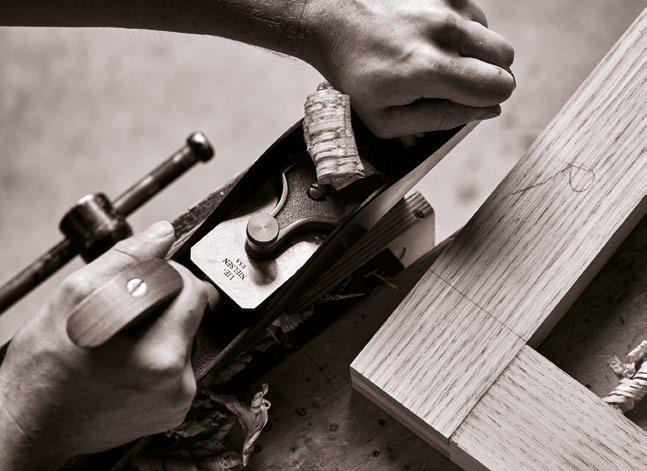
PHOTOGRAPH ACKNOWLEDGEMENTS
Imagery used throughout by Petr Krejčí
Yale Forestry School by Morley von Sternberg
Migo 01 and Concur by Jason Yates
Thought Bubble and Checkered by Winston Chuang
Bloomberg HQ by James Newton and Nigel Young (Bloomberg)
Nieuwegein’s Theatre by Allard van der Hoek
Au Pain Doré by Adrien Williams
The Black and White Building and MultiPly in London by Ed Reeve
The Smile by Tom Donald
Endless Stair by Judith Stichtenoth
Mesamachine by David Cleveland
Royal Academy of Music by Adam Scott
Mit Mat Mama by Adrià Goula
Maggie’s Oldham by Alex De Rijke and Jon Cardwell
Heydar Aliyev Airport by Sergio Ghetti
Church Crescent by Jaine Airey
The Living Staircase by Mark Cocksedge
Lord’s Warner Stand by Jon Cardwell
Mechelen Museum by Hof van Buysleden
The Apex by Morley von Sternberg
Worth Abbey by Edmund Sumner
Bourke Street Bakery by Michael Vahrenwald
Essay 4 by Jaime Navarro
The Linbury Theatre by Hufton and Crow
The Butler by Giovanni Nardi
For more than three decades, the American Hardwood Export Council (AHEC) has been the global face of the U.S. timber industry, championing the performance, sustainability and aesthetic potential of American hardwoods worldwide. AHEC’s global programme secures a future for American hardwoods by demonstrating the performance and aesthetic potential of these sustainable materials, while providing valuable creative inspiration and technical assistance.
From Washington, DC and six overseas offices, strategically located in key hardwood markets, AHEC conducts a worldwide non-profit promotion programme with activities in more than 35 countries. All programmes are run though the joint efforts of the U.S. hardwood industry and the Foreign Agricultural Service (FAS) of the U.S. Department of Agriculture (USDA).
www.americanhardwood.org
AHEC OFFICES:
U.S. Headquarters www.ahec.org
Europe europe@americanhardwood.org
Middle East & Africa mena@americanhardwood.org
Australia/New Zealand oceania@americanhardwood.org
China & Southeast Asia info@ahec-china.org
Mexico & Latin America info@ahec-mexico.org
Japan
info@ahec-japan.org
India (also Nepal, Bangladesh & Sri Lanka) india@americanhardwood.org
The export industry we represent is made up of companies, many still family owned, that are either sawmills, veneer producers, moulding and flooring producers, traders with concentration yards and kilns or combinations thereof. Together this industry exports in baulk (by container) to over 50 countries worldwide more than 20 commercially available hardwood species.
AHEC is a voice for the hardwood industry in export markets and represents the committed American hardwood exporters and the major U.S. hardwood product trade associations.
ASSOCIATION PARTNERS:
American Walnut Manufacturers Association (AWMA) www.walnutassociation.org
Appalachian Hardwood Manufacturers, Inc. (AHMI) www.appalachianwood.org
Hardwood Manufacturers Association (HMA) www.hardwoodinfo.com
Decorative Hardwood Associations (Formerly HPVA) www.decorativehardwoods.org
National Hardwood Lumber Association (NHLA) www.nhla.com
National Wood Flooring Association (NWFA) www.woodfloors.org
Western Hardwood Association (WHA) www.westernhardwood.com
Northeastern Loggers’ Association (NELA) www.northernlogger.com
Wood Component Manufacturers Association (WCMA) www.woodcomponents.org